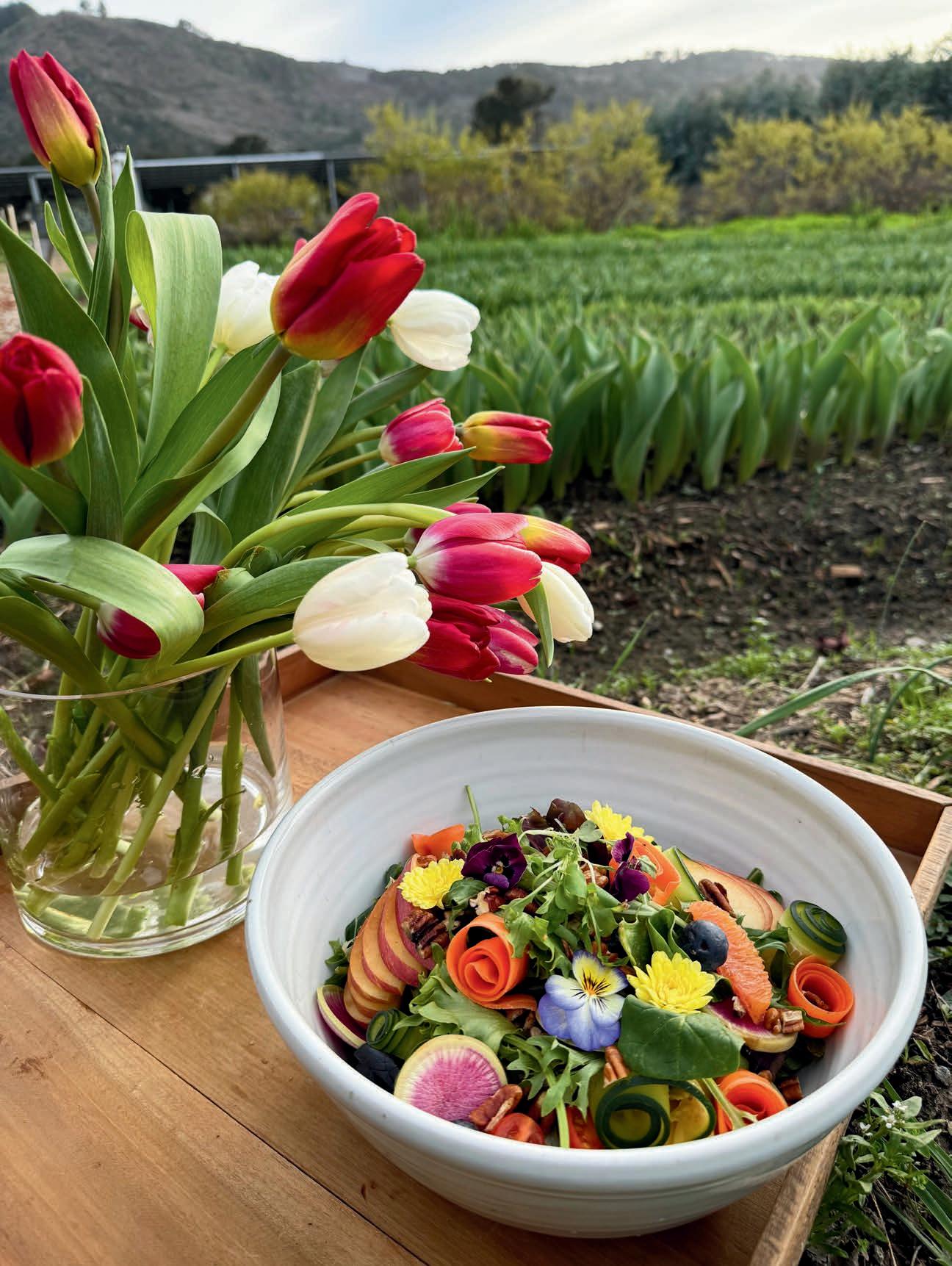








Enjoy sweet, locally grown berries this season.




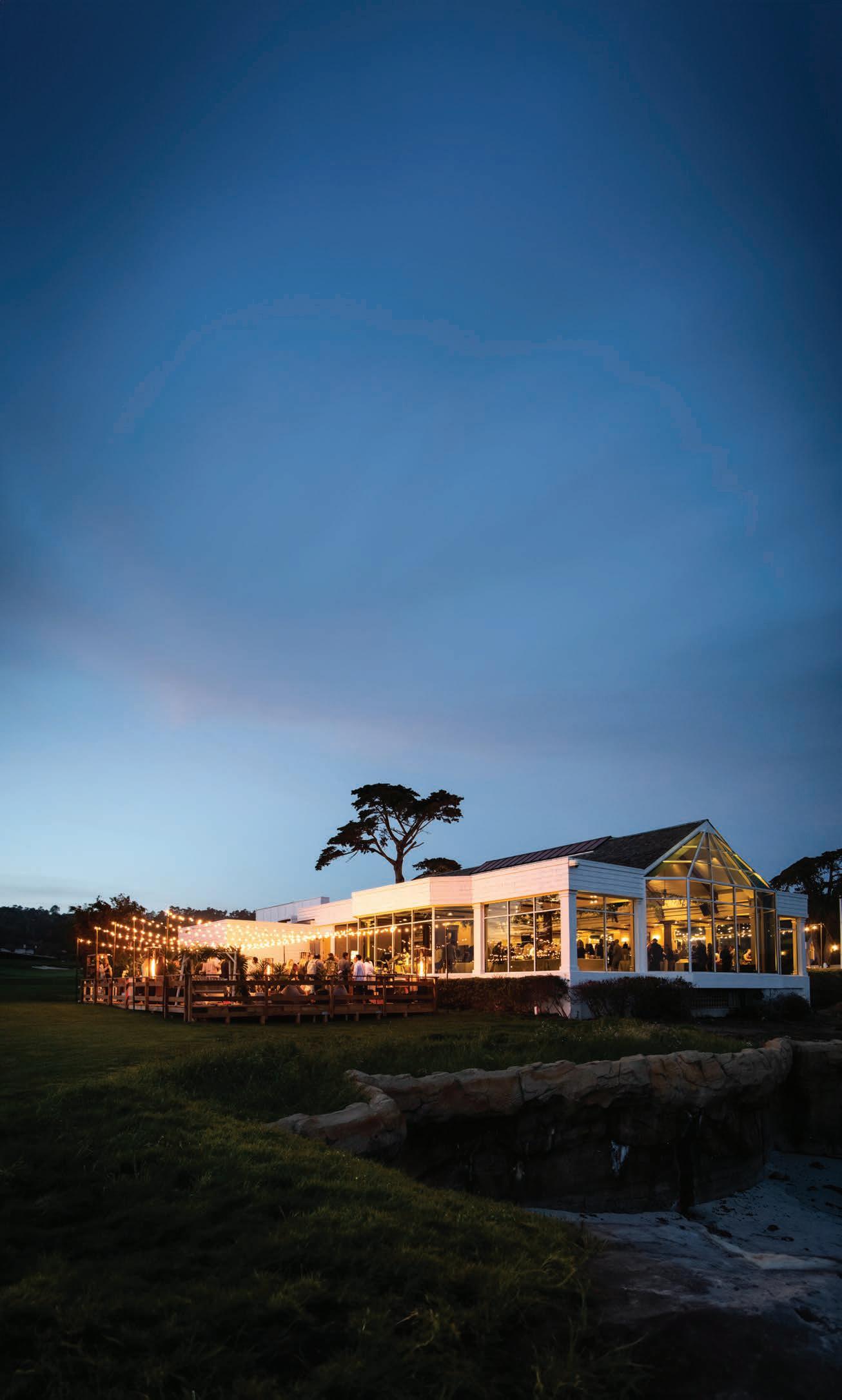
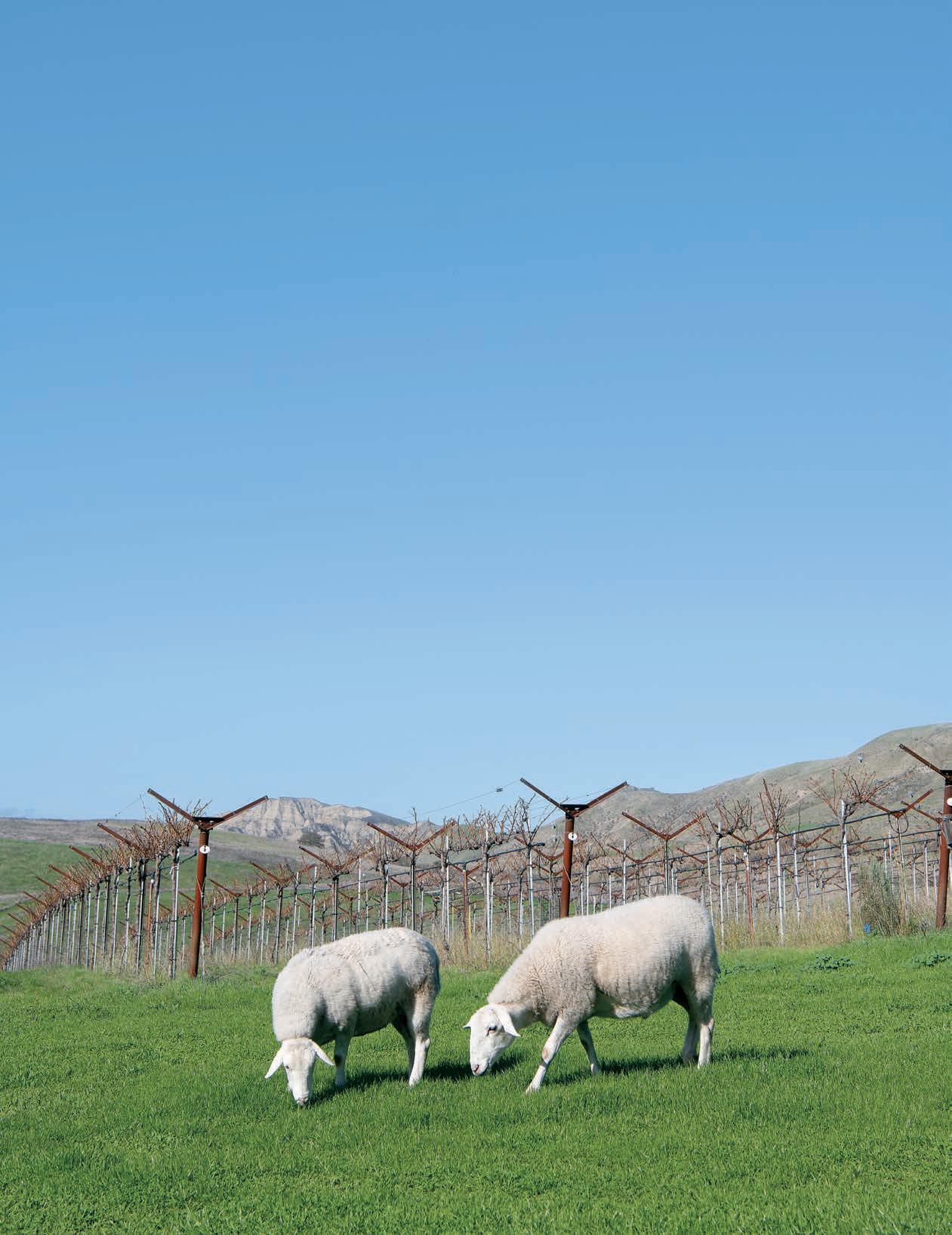
4 GRIST FOR THE MILL
7 E DIBLE NOTABLES
Lupita Quintero: The unexpected farmer; View from the Top: New weekly lunches at Paicines Ranch tie together the land and its bounty; Seed Sorceress: Meet the Felton gardener behind a beloved brand; Mistress of Mold: Tempeh is about to hit the big time, if Funky Bean founder Katie Belanger has her way
22 W HAT’S IN SEASON WILD ELDERFLOWER
Nature’s springtime treat
26 L OCAL FOODS IN SEASON
29 COOKING WITH THE SEASONS CAVALLETTA
Chef Nick Sherman makes gnocchi for his latest restaurant
33 FOODSHED SPRING FARMERS MARKETS
A complete guide for the Monterey Bay area
36 ON THE BAY NEAR DEATH DIAGNOSIS
Haunting reports on the fragility of remaining local fishers
45 I N THE KITCHEN DEFYING AUTHENTICITY
Exploring the links between Asia and the Americas
52 ON THE FARM R AISING RABBITS
The other “other white meat” is a highly nutritious, sustainable protein, so why aren’t we eating more of it?
59 E DIBLE COMMUNITY
A LCHEMY ON TAP
Roxa Hammock Cafe concocts herbal beverages and mystical experiences
62 E DIBLE D.I.Y.
PROLIFIC PERENNIALS
7 vegetables to plant now and enjoy for years to come
69 DINE LOCAL GUIDE
80 L AST CALL MELON MAN
Globetrotting mixologist settles down in Salinas
RECIPES IN THIS ISSUE
21 Fresh Tempeh
25 Elderflower Syrup
25 Elderflower Mocktail
30 Ricotta Gnocchi with Arugula Pesto and Spring Vegetables
47 Chinese Chili Oil
48 Salsa Macha
50 Salmon Tostadas
80 Melon Man Cocktail
COVER PHOTOGRAPH
Fisherman Jiri Nozicka by Mark C. Anderson
CONTENTS PHOTOGRAPH
Vineyards at Paicines Ranch by Coline LeConte

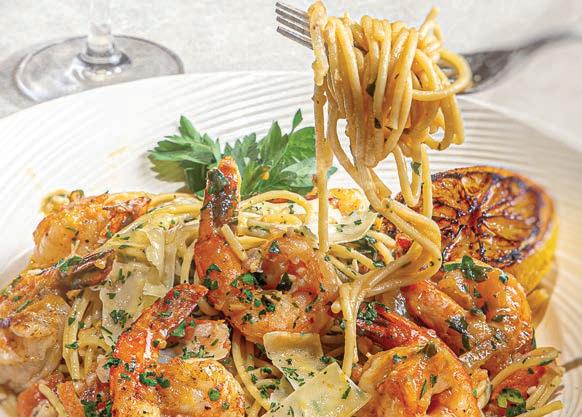
California Cuisine
Locally sourced ingredients paired with award-winning wine and cocktails
Breakfast: 6:30am to 10:30am
Dinner: 4pm to 10pm jacksatportola.com
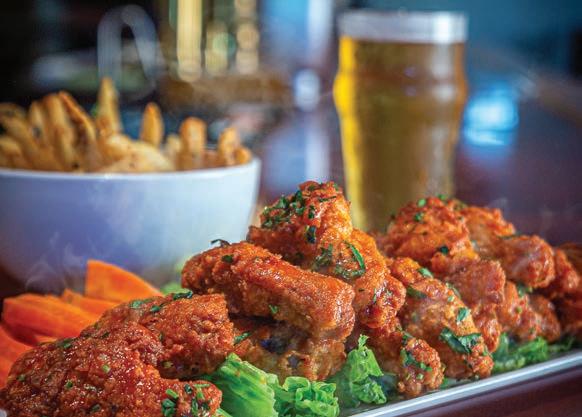
Monterey’s Original Craft Brewery
Serving award-winning craft beer with a pub style menu and sports on 18 HDTV’s
Happy Hour: 4pm to 6pm & 9pm to 10pm peterbsbrewpub.com
Find your foodway. That phrase has been rattling around in my head for the past few weeks and I can’t remember if I heard it somewhere or saw an Internet meme or if it came to me in a dream. But it’s good advice and makes a fitting slogan for this magazine.
Edible Monterey Bay has always been about showing the way, by spotlighting our local food community so that we the eaters can better know our farmers, fishermen and the people who prepare our food in area restaurants.

Unfortunately one pillar of the Monterey Bay foodshed is in serious trouble. In this issue we report on the sad situation of local fishermen and women, who are leaving the profession in droves due to a canceled salmon season last year, restrictions on crabbing and various ground fish closures. Contributing editor Mark C. Anderson explains why it is getting harder and harder to catch and eat local seafood, and where the fishermen are going.
But it’s not all gloomy news. Even though another winter storm is pounding down as I write this, the acacias have begun to bloom, robins are singing again every morning and soon it will be time to start planting a summer garden.
We have plenty of inspiration for gardeners and cooks in this edition. Also, you will meet hard working farmers and creative food entrepreneurs. And don’t forget to read the ads; they will point you to a bumper crop of exciting new businesses and long-established ones that form the fabric of the Monterey Bay area foodway.
A foodway is defined as the eating and culinary habits of a certain people or region. Let Edible Monterey Bay help you find your foodway.
 Deborah Luhrman Publisher
Deborah Luhrman Publisher

At Edible Monterey Bay , our mission is to celebrate the local food culture of Santa Cruz, San Benito and Monterey counties, season by season. We believe in sustainability, and we believe everyone has a right to healthful, clean and affordable food. We think knowing where our food comes from is powerful, and we hope our magazine, website and newsletters inspire readers to get to know and support our local growers, fishers, chefs, vintners and food artisans.
EDITOR AND PUBLISHER
Deborah Luhrman
deborah@ediblemontereybay.com
831.600.8281
FOUNDERS Sarah Wood and Rob Fisher
CONTRIBUTING EDITOR
Mark C. Anderson
ASSOCIATE EDITOR Laurel Miller
COPY EDITOR Doresa Banning
LAYOUT & DESIGN Matthew Freeman and Tina Bossy-Freeman
AD PRODUCTION COORDINATOR
Tracy Smith
AD DESIGNERS Bigfish Smallpond Design
Julie Greene • Coline LeConte • tracysmithstudio
Zephyr Pfotenhauer
CONTRIBUTORS
Analuisa Béjar • Coline LeConte • Kathryn
McKenzie • Ashley Drew Owen • Laura Ness
Geneva Rico • Jillian Steinberger-Foster
Patrick Tregenza • Michael Troutman • Jessica
Tunis • Amber Turpin • Patrice Vecchione
Angel Welch
ADVERTISING SALES
ads@ediblemontereybay.com • 831.600.8281
Shelby Lambert shelby@ediblemontereybay.com
Kate Robbins kate@ediblemontereybay.com
Aga Simpson aga@ediblemontereybay.com
Fran Fitzharris fran@fitzharris.com
DISTRIBUTION MANAGER
Mick Freeman • 831.419.2975
CONTACT US:
Edible Monterey Bay P.O. Box 487
Santa Cruz, CA 95061
ediblemontereybay.com 831.600.8281
info@ediblemontereybay.com
Edible Monterey Bay




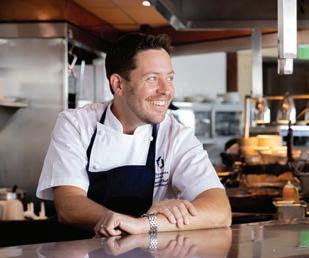
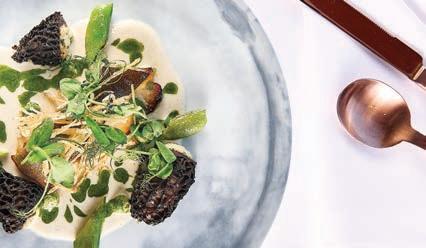









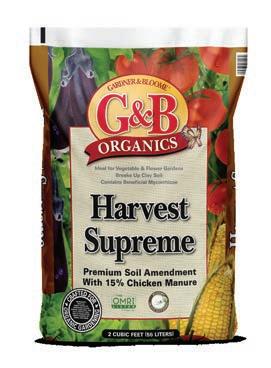

Aptos Landscape Supply
5035 Freedom Blvd.
Aptos, CA 95003 (831) 688-6211
Bokay Nursery
30 Hitchcock Road
Salinas, CA 93908 (831) 455-1868
Dig Gardens
420 Water St.
Santa Cruz, Ca 95060 (831)466-3444
7765 Soquel Dr. #A Aptos, CA 95003 (831) 688-7011
Drought Resistant Nursery
850 Park Ave.
Monterey, CA 93940 (831) 375-2120
Far West Nursery 2669 Mattison Lane
Santa Cruz, CA 95062 (831) 476-8866
The Garden Company 2218 Mission St. Santa Cruz, CA 95060 (831) 429-8424
Griggs Nursery 9220 Carmel Valley Rd. Carmel, CA 93923 (831) 626-0680
Hana Gardens
899 Rosita Rd. Del Rey Oaks, CA 93940 (831) 920-1231
1177 San Pablo Ave. Seaside, CA 93955 (831) 393-0400
M. J. Murphy Lumber
10 W. Carmel Valley Rd.
Carmel Valley, CA 93924 (831) 659-2291
Martins’ Irrigation
420 Olympia Ave. Seaside, CA 93955 (831) 394-4106
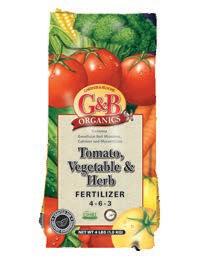



Mountain Feed & Farm 9550 Highway 9
Ben Lomond, CA 95005 (831) 336-8876
The Plant Works
7945 Highway 9
Ben Lomond, CA 95005 (831) 336-2212
San Lorenzo Garden Center 235 River St.
Santa Cruz , CA 95060 (831) 423-0223
Scarborough Gardens
33 El Pueblo Rd. Scotts Valley, CA 95066 (831) 438-4106
Sierra Azul NurseryGarden
2660 E. Lake Ave. Watsonville, CA 95076 (831) 728-2532
Tope’s Sustainable Garden Center
115 Monterey Salinas Hwy Salinas, CA 93908 (831) 455-1369
Valley Hills Nursery
7440 Carmel Valley Rd. Carmel, CA 93923 (831) 624-3482
hen shopping at the Seaside Farmers Market one Thursday afternoon, trying to decide what to make for dinner, the filigreed heads of lettuces and rainbow chard at Lupita Quintero’s stand caught my eye. But there was something more than her vegetables and bright orange marigolds that drew me near.
Before approaching, I stood watching as Lupita welcomed each shopper as though they were friends she’d not seen in far too long. Though we’d never met, that’s how she greeted me, too. With a twinkle in her brown eyes conveying an enthusiasm for life, Lupita’s beautiful. She’s effervescent without being bubbly, and her laughter is infectious. I couldn’t help myself from buying not one, but three large bunches of marigolds, lettuce for several salads and carrots enough for soup.
The next time I went to her market booth, she was speaking in Spanish to another woman, said hello to me by name and kindly switched to English. They were talking about the shopper’s new business—a food truck. Lupita told her how important it is to serve organic. “Come to my farm when you are ready,” she told her. “You can buy the vegetables you want for whatever you can afford to pay.” Lupita is not only magnetic, she’s also generous.
On just one acre of land in San Juan Bautista, Lupita grows chard, lettuce, kale, marigolds and carrots, as well as broccolini, red cabbage, Napa cabbage and strawberries, depending on the season. “A little bit of everything,” she says.
But it wasn’t always this way. Though farming’s in her blood, Lupita had an entirely different life—or lives—before putting her hands in the soil and later pulling carrots from it.
Farming was not her first career, but

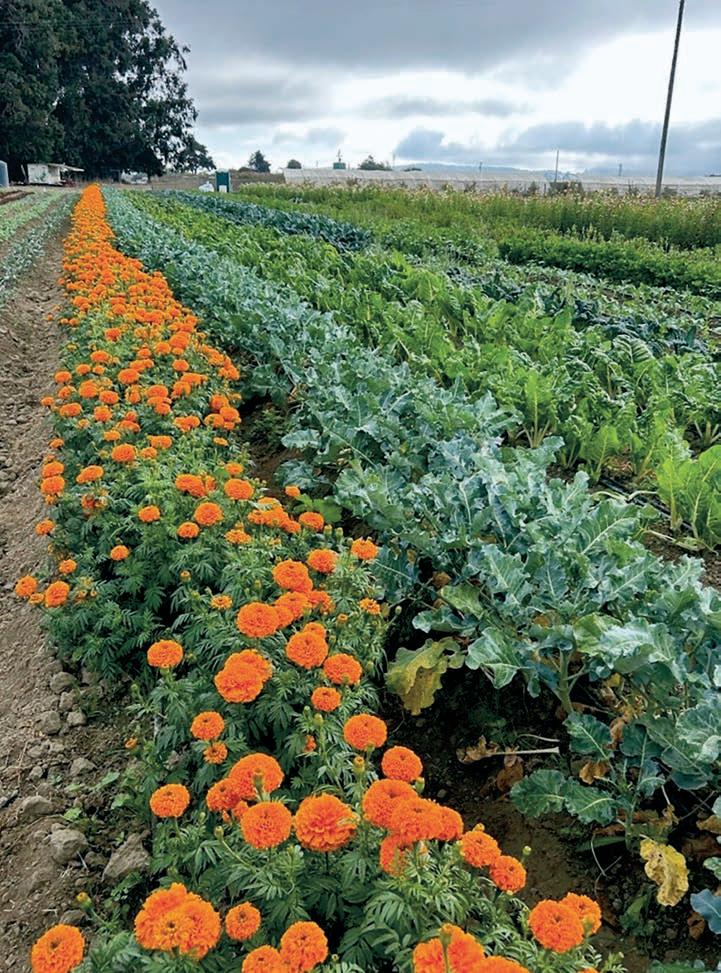
“I was an industrial engineer in Nogales, Sonora, Mexico where, in the late 1980s into the ’90s, I worked for a garage door opener manufacturer,” she says. “I’d graduated from engineering school where I was the only woman among 51 men.”
And then her husband, an engineer also, was offered a job in San Diego.
“I didn’t want to go! We never had plans to move to the other side.” She thought they had a future in Mexico. “But my husband said, ‘Give me one year,’ so I said, ‘Okay.’ That was 25 years ago. Coming to the U.S. changed our lives. Here there is more opportunity, not only for me, but better education for my children. Here it’s better for women, and I have a daughter. I have no regrets about coming. My husband has a master’s degree now, that we’re still paying for. It’s a privilege to have the opportunities that we have here.”
She went to school to learn English while her children were in school. “After four years, once my English was good enough, I went to community college.”
Eventually her family relocated to Santa Cruz County. “I had a daycare center in my home,” and then she worked as a preschool teacher. “Everything was perfect until COVID came.”
She felt discouraged, but, clearly, they didn’t know Lupita’s strength and determination.


Her husband asked, “Is there something you would like to do, something you would like to learn?” He was surprised when she replied, “Agriculture.” Lupita enrolled in an ag program, where she was stimulated and excited by what she was learning. However, there were some people in her life who doubted her new direction. They wondered if she was too old to become a farmer, if the equipment she’d be working with would be too heavy. She felt discouraged, but, clearly, they didn’t know Lupita’s strength and determination. “I have good friends, and my husband said, ‘We are equal. You have the same rights. Don’t stop! Don’t set limits.’”
That wasn’t the only thing holding Lupita back. She was hindered also by societal expectations, “In my culture, women of my age should not be doing this. You can see women at 65 working in the fields, picking strawberries, cleaning houses, and it’s fine.”
But there isn’t support for women Lupita’s age—she’s 58—to become entrepreneurs, and that weighed on her. How true for any of us who step beyond the expectations—spoken or unspoken— that have been set for us. Not even this could stop her desire, curiosity and determination.
“Now I have my own tractors,” she says, excitedly. “I have money to buy seeds. I make money and spend money on the farm.” Her plan is to rent another two or three acres. “When I get more land, I’m going to be ready to grow more. I’m going to have basil, oregano, radishes and more flowers.”
And then there’s earning a living as a new farmer—a challenging thing to do. A friend of Lupita told her, “I want to see you making money.” Lupita held up her hands to me: “Do you think it’s a hobby when you see my hands in bad shape? I do need the money but I want to learn. The money will come, I think. If I have success, it will be good.”
She continues, “The most important part, when I grow the flowers, the hummingbirds, the monarchs are all around. It’s amazing how much we can learn from nature.” She recalls an experience last summer. Upon returning to her farm after being away for a few days, she was surprised to see her first dinner-platesized dahlia. “It’s huge! It’s huge! This is the emotional part of agriculture.”
Then Lupita got quiet. She looked off into the distance, back in time, to a memory of her grandfather who was still farming when he was in his early 90s. “He was Yaqui from Sonora. My grandfather used to talk to the wind and to the sky, asking for water for the plants, for better weather. I never liked when he did that. But now, when it’s raining, I say, “God, please stop the rain!” Lupita leaned into her laughter, and said, “I’m becoming my grandfather!”
Monterey writer and artist Patrice Vecchione’s latest books are Ink Knows No Borders: Poems of the Immigration and Refugee Experience and My Shouting, Shattered, Whispering Voice: A Guide to Writing Poetry & Speaking Your Truth. Check out her art installation Imagination Migration on display this spring at Sweet Elena’s Artisan Bakery and Cafe.





Find your FABULOUS and so much more!

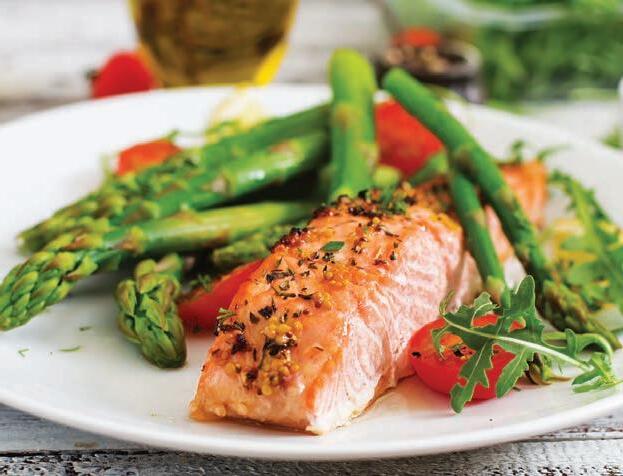

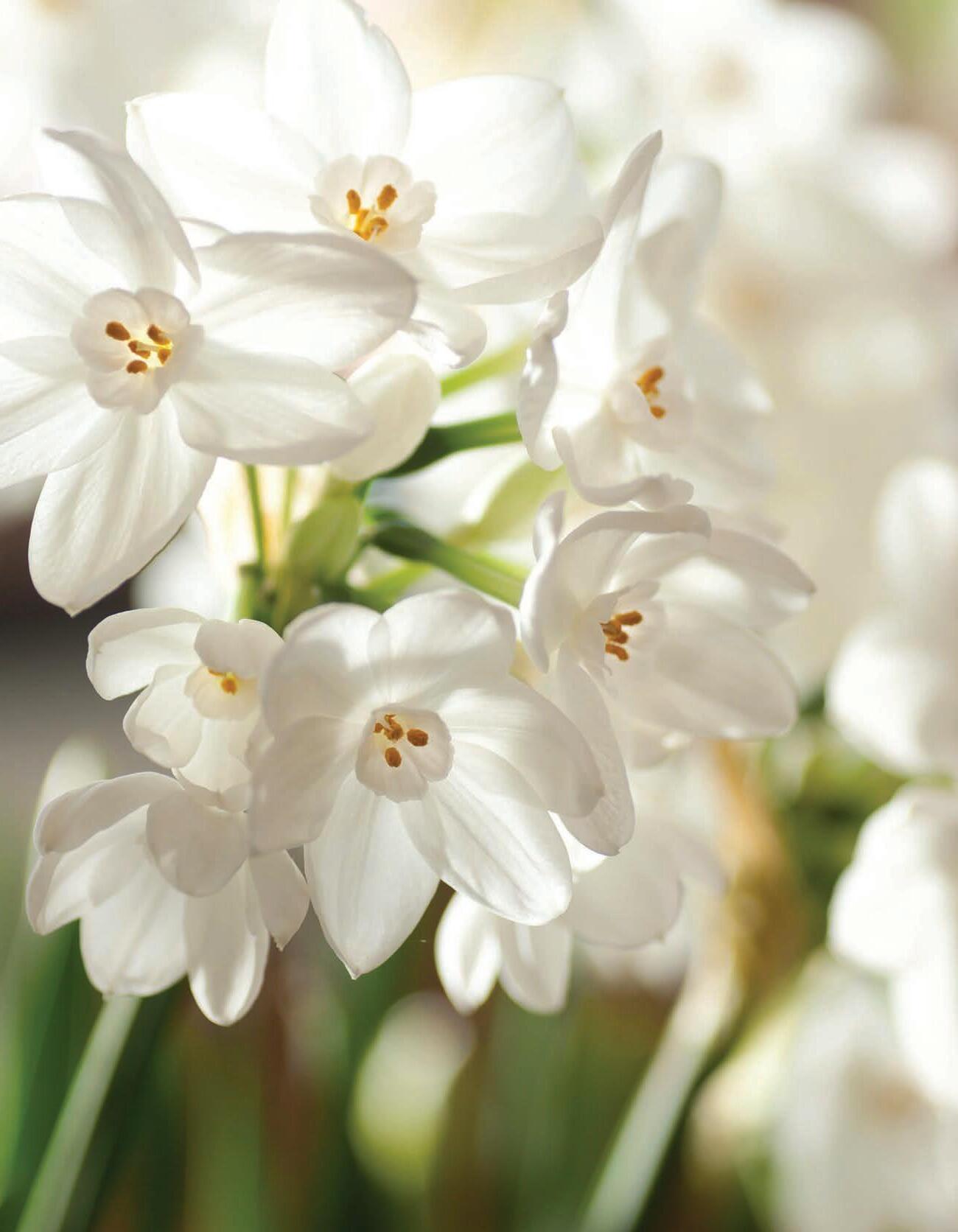





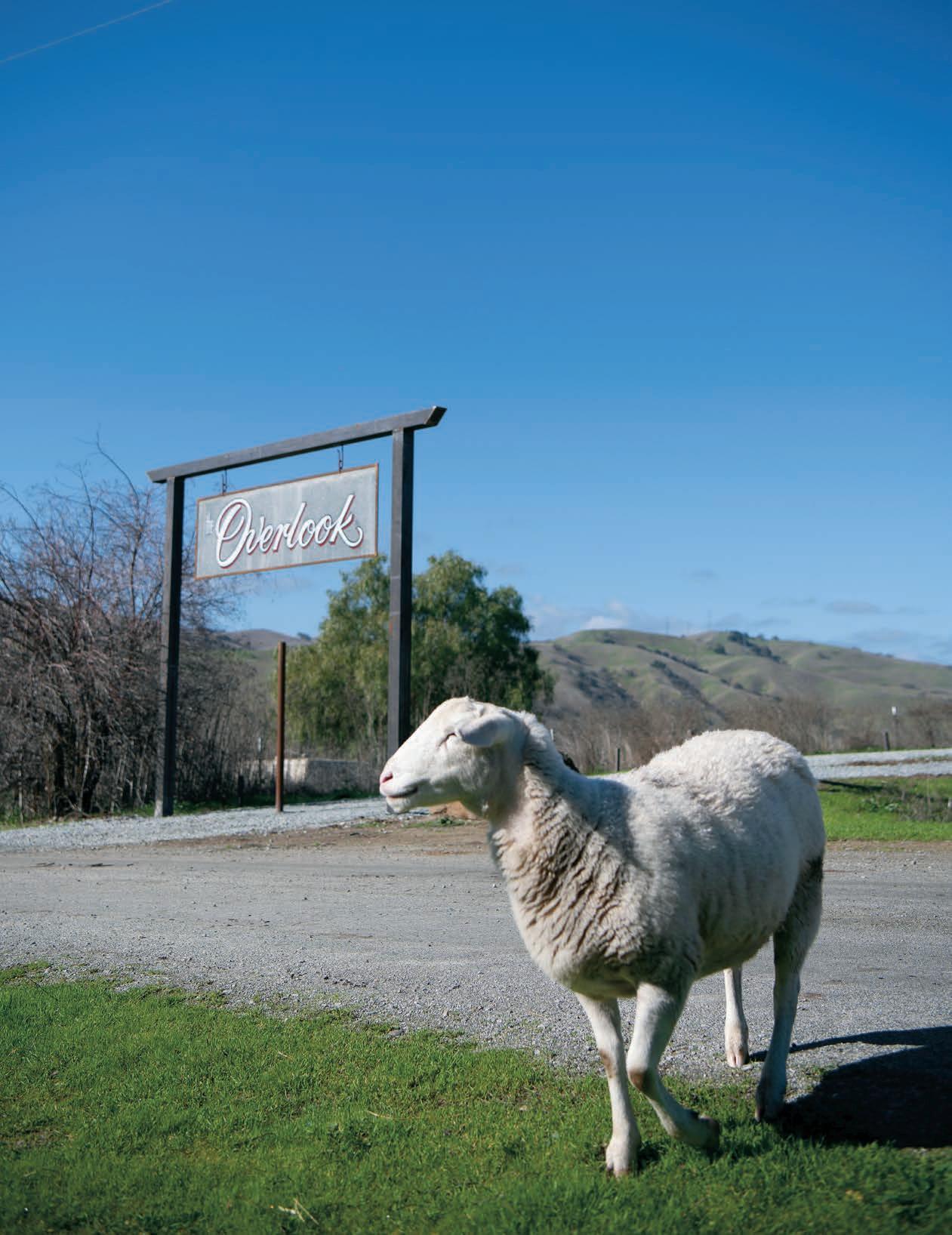
When meandering among the old barns and outbuildings that give Paicines Ranch its special rustic character, it’s a slight visual shock to come upon the Overlook—the ranch’s new dining spot—a sleek metal and glass building in tones of red, steel gray and black.
From the expansive patio, visitors can see the Gabilan Mountains as a dramatic backdrop with a ridge of smaller hills in front and the San Benito River wending its way through groves of valley oaks. On this particular day, the scene couldn’t be more perfect—puffy clouds dotting the blue sky, mirroring the four fluffy sheep below which are grazing in an adjacent meadow.
“You’re eye-level with the hawks here,” says Paicines Ranch co-owner Sallie Calhoun, sitting down to lunch and gazing out over the river valley. “You can watch the sunset from here, 365 days a year.”
Why is it called the Overlook? “Well, that’s what we’d been calling it, and it just kind of stuck,” says business manager Mary Rowen.
Calhoun, who with husband Matt Christiano bought the historic ranch in 2001, has been working ever since to rebuild the ecosystem. Now, she says with satisfaction, the riparian corridor is coming back to life, creating habitat that attracts hundreds of species of birds and other wildlife. The sheep in the foreground— “hospitality sheep” in ranch parlance—are a reminder that it is possible to produce meat sustainably, in ways that will renew the environment rather than deplete it.
The Overlook is just the latest chapter in the Paicines Ranch story. Calhoun’s dream began with the idea of restoring native grasses and plants to the land; the ranch’s mission has grown and expanded since then, and it’s now a destination as well as a passion project. Its lodgings range from glamping tents to cozy cottages to fourbedroom houses, and the ranch has venue space to accommodate weddings, retreats and other special events.
With all that going on, providing quality food became important as well. Under the guidance of executive chef Carlos Canada and his wife, events and catering manager Nancy Sorgatz, food service highlights ranch-produced meats and fresh local produce with menus that follow the seasons.
The idea of the Overlook “incubated for a long time,” says Calhoun. Although the concept was planned years ago, construction was delayed by the pandemic. The Overlook finally opened as a multi-purpose, LEED-certified facility that can seat up to 200 people indoors and out—a recent EcoFarm conference lunch held there hosted 120—and it includes a wine bar featuring vintages made from grapes grown on the ranch.
But Calhoun wanted to go a step further, and that’s what prompted serving weekly lunches for the public at the ranch. “We have so much amazing food produced right here, and this is a space that we can provide to bring the community together,” says Rowen.
On a recent Thursday, lunch attendees included hikers bound for Pinnacles National Park, ranchers from nearby properties, Paicines Ranch staffers and people from nearby communities who just wanted to get out and enjoy the sunshine. On other Thursdays, the crowd might include visitors from the nearby Thousand Trails RV campground or people taking a break from tastings on the Cienega Valley wine trail.



“You can watch the sunset from here, 365 days a year.”
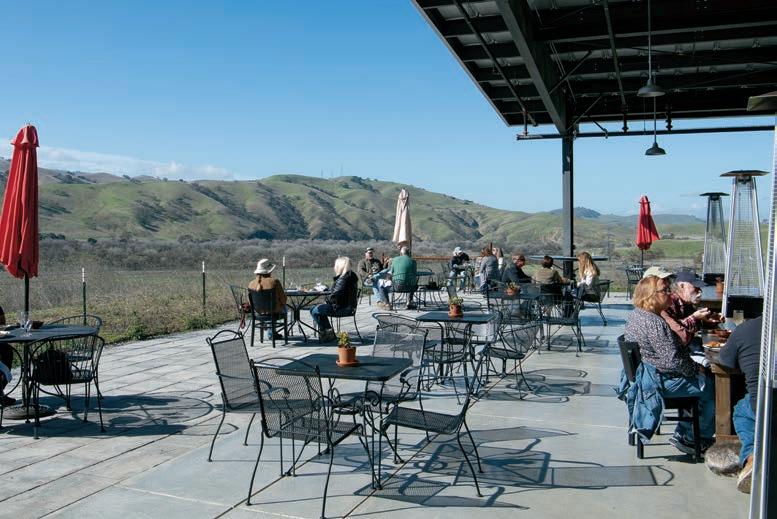
On this day there was a choice of either beef or lamb burgers, served with fries or potato salad, and each meal included a spring mix-carrot-apple salad and a freshly baked cookie for dessert.
A different menu is posted for each weekly lunch, with all ingredients coming from local organic farms to complement the ranch’s grass-fed and pastured meats. Rowen points out that all lunches must be reserved beforehand through the ranch website, with seatings from 11:30am to 1:30pm.
“We only use proteins raised on the ranch,” says Canada, who joined the ranch team as head of food and beverage in 2021. For other ingredients, he visits local farmers markets, and also has vendors who bring items to the ranch. He draws inspiration from what’s fresh and in season: “My best way to cook is to have those relationships with the farmers.”
The lunches are a way not only to highlight ranch-produced products, but also to build a sense of community in a rural and sparsely populated area of south San Benito County. “It’s about the local food hub and
it’s a way to support local food producers,” says Rowen. It also provides another draw for visitors to San Benito County.
Calhoun and Canada have big plans for expanding in the coming months. A Mother’s Day brunch is also in the works, as are cooking and food preparation classes that use simple ingredients and methods to create delicious meals, Canada says. Special dinners and added lunch days may also be a possibility.
“It’s a dream come true,” says Calhoun. “It’s all about eating, talking and trying to change the world.”


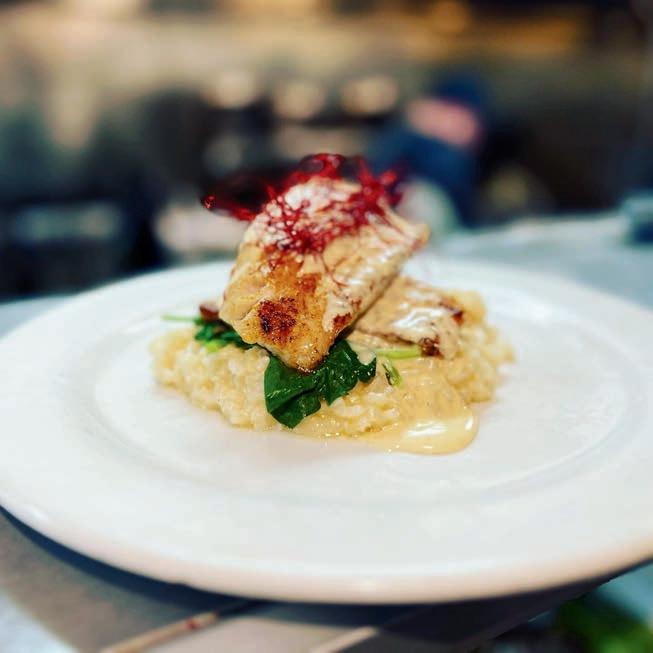
Overlook • most Thursdays 11:30am−1:30pm by advance reservation only • 13388 Airline Hwy., Paicines • paicinesranch.com
Kathryn McKenzie, who grew up in Santa Cruz and now lives on a Christmas tree farm in north Monterey County, writes about the environment, sustainable living and health for numerous publications and websites. She is co-author of Humbled: How California’s Monterey Bay Escaped Industrial Ruin.
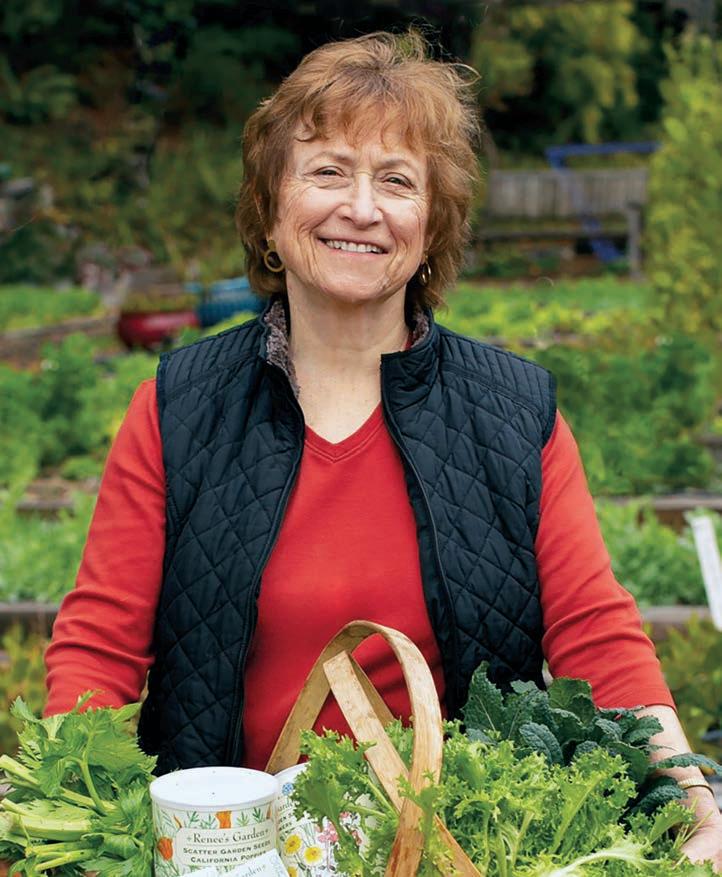
Does your pulse quicken when you pick up a packet of seeds? If so, you might be a gardener at heart.
Even if you’ve never so much as put a kernel of corn in the dirt, you cannot help but be drawn to the colorful watercolor illustrations on the packets of Renee’s Garden seeds. They’re displayed where organic food is sold and at independent garden shops and nurseries nationwide.
For Renee Shepherd, finding easy-to-grow varieties for kitchen gardeners that produce tasteful, nourishing meals has been her life’s mission for nearly 40 years. “We want home gardeners to be successful, so we trial things constantly,” she says.
At the trial gardens in the foothills of Santa Cruz and at her ½-acre organic test plot in Felton, where she has lived since 1979, everything is grown carefully and evaluated. “Our trial garden manager and staff test as many as 280 varieties yearly in long raised beds. We have always used organic products and practices,” she says.
Meet the Felton gardener behind a beloved brand
BY LAURA NESS
Weekend visits to her grandmother’s house instilled a love of gardening.
Because the company markets its seeds nationally, chosen varieties are also trialed in Vermont to make sure they will grow in cold weather climates.
Shepherd hails from Euclid, Ohio, where weekend visits to her grandmother’s house instilled a love of gardening. She came to UC Santa Cruz to pursue a PhD in intellectual history and then spent a few years as an instructor in the Environmental Studies Department. Her decision to stay in Santa Cruz was easy: “I love Santa Cruz, and another big motivator is I could finally have a horse of my own here!” Her property includes an irrigation pond and having access to adequate water was an important reason she could develop the first trial garden.
Renee’s Garden is her second bloom, as it were. The first was a catalog company called Shepherd’s Seeds, created in 1985 and initially run from her home. The company featured 60 different kinds of seeds in packets distinguished by sepia line art. She moved on to establish Renee’s Garden in 1998, with its eye-catching watercolor renderings of the magic awaiting within.
San Francisco botanical artist Mimi Osborne has been creating Shepherd’s seed packet illustrations from the beginning, starting from multiple photos of each variety taken in the trial garden. Osborne first completes a detailed pencil sketch from the photos before creating the watercolor portrait.

“Seeds come from all over the world,” says Shepherd, careful to note she is not a seed grower, but a seed sourcer. “We bring in seeds from the U.S., France, the Netherlands, Italy, India, the Czech Republic, South Korea, Mexico, Thailand, Japan…all over. I have two criteria: they have to be productive and in the case of vegetables, great tasting. Flowers have to be easy to grow and beautiful.”
During the pandemic, all packet seed companies saw a 100% increase in sales. While it’s no longer at that level, Shepherd says, “Once you catch the gardening bug, you never look back.”

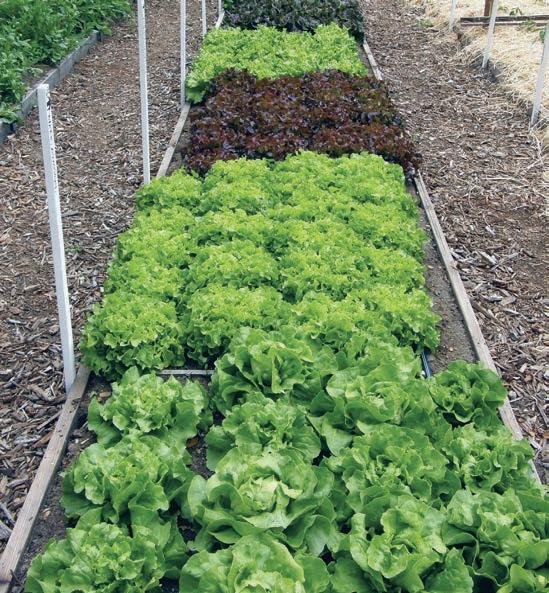
After the consolidation of garden centers and buyouts by the big box stores in the 1990s and the recession of 2008-2009, she’s encouraged by a renaissance of small garden centers, including feed and seed stores. “It’s like the return of independent bookstores.”
Renee’s Garden is a cornucopia of choice. The company offers 26 different varieties of sweet peas and 18 different zinnias, six different regional Italian basils, eight types of kale and a huge variety of lettuces.
But, she notes that a big variety does not make her a “big” company. For reference, Renee’s Garden sells between 7 and 10 million packets yearly; Burpee sells 20 million.
One of her best sellers, and a personal favorite, is the “cut and come again” mesclun baby leaf mixes. “I first saw and tasted mixed baby greens from weekly markets in France about 25 or 30 years ago, and was the first to introduce seed mixes for baby leaf blends in the U.S.”
The inspiration for Renee’s Garden seed company came from Shepherd’s own raised bed garden in Felton, but has grown to include seeds for close to 1,000 varieties of vegetables, fruits and flowers.
She encourages people to grow their own favorite vegetables and herbs, as well as flowers to support a healthy ecosystem. “Growing your own home garden, even a container garden, can be helpful in sustaining a wide range of pollinators. Plus, there’s the joy and pleasure in growing your own food,” she adds.

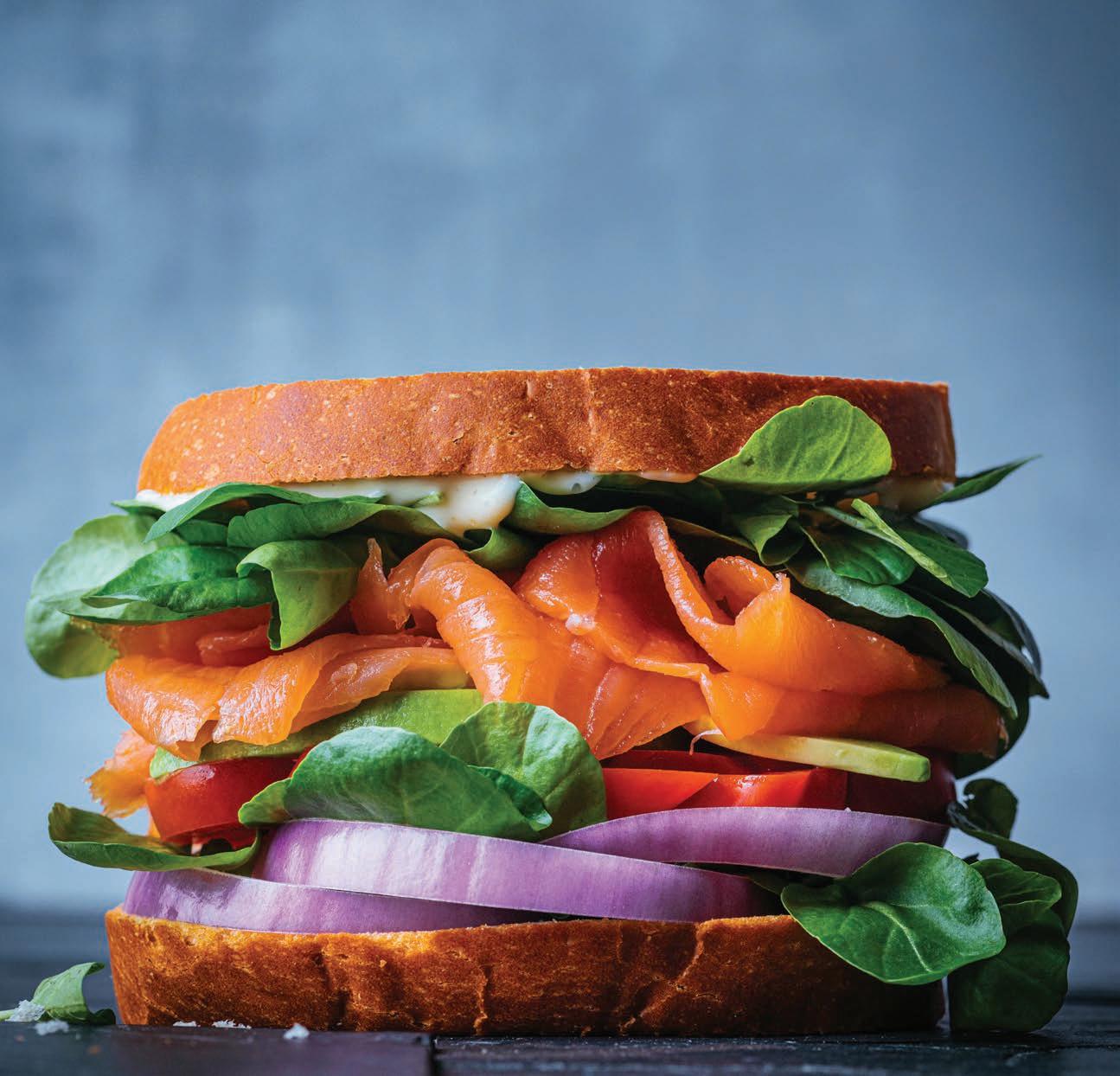
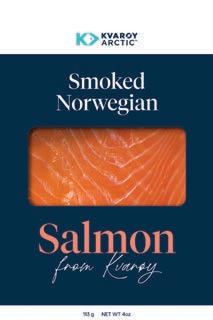
Kvarøy Arctic Smoked Norwegian Salmon is the perfect way to add salmon to your dishes any day of the week. At Kvarøy Arctic, our smokehouse experts naturally smoke the salmon with extravagant care and technique, creating a luxurious mild flavor that will transport you to the great Norwegian outdoors.

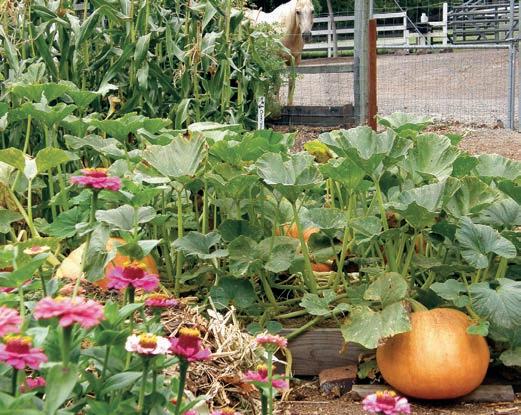
Regarding growing tomatoes in our fog-influenced climate zone, Shepherd says sturdy varieties such as deep orange sungold cherry tomatoes and stupice red round tomatoes are good choices for near the coast. “Stay away from big fruited heirlooms that were developed for hot humid climates because they just won’t cooperate in cool, foggy, coastal summer weather.”
To help combat hunger and promote gardening in a hands-on way, Renee’s Garden donates seed packets to a wide variety of groups, including community gardens, school garden programs and prison gardens. ”Locally, we donate to Cabrillo College, LifeLabs, UCSC and many nonprofits, plus senior living facilities, many of which are starting to have small gardens for their residents to work in and enjoy,” says Shepherd.
What to do with all that produce? Take inspiration from one of her three cookbooks, prompted by customer questions like, how do I use radicchio or cook Romano beans. Recipes From A Kitchen Garden, More Recipes From A Kitchen Garden and The Renee’s Garden Cookbook are all organized by vegetable, so you can quickly find recipes for squash, broccoli, basil and so forth.
The website is filled with tips, like when to pick basil to make it last longer, how to make pesto (she uses oregano and parsley as well as basil), and gardening videos.
Lack of space shouldn’t limit your imagination. Renee’s Garden specializes in containers plants. “We have a French zucchini that does not scroll or vine and all the fruit grows in the center. We have patio cucumbers, peppers, tomatoes, and dwarf kale and chard that grow perfectly in a pot. We have short sweet peas and compact nasturtiums and zinnias that all do well in containers,” she says.
Ideal container tomatoes include stupice and Tasmanian chocolate, a cross between brandywine and green zebra with mahogany and orange stripes.
“Planting seeds is an ecumenical act,” Shepherd says. “Our job is making sure our customers are successful, and that their food is nutritious, delicious and fun. Go out and pick your dinner. And remember, there should be no politics around dinner.”
Laura Ness is a longtime wine journalist who contributes regularly to Edible Monterey Bay, Los Gatos Magazine and the Wine Industry Network, sharing stories of the intriguing characters who inhabit the world of wine and food.





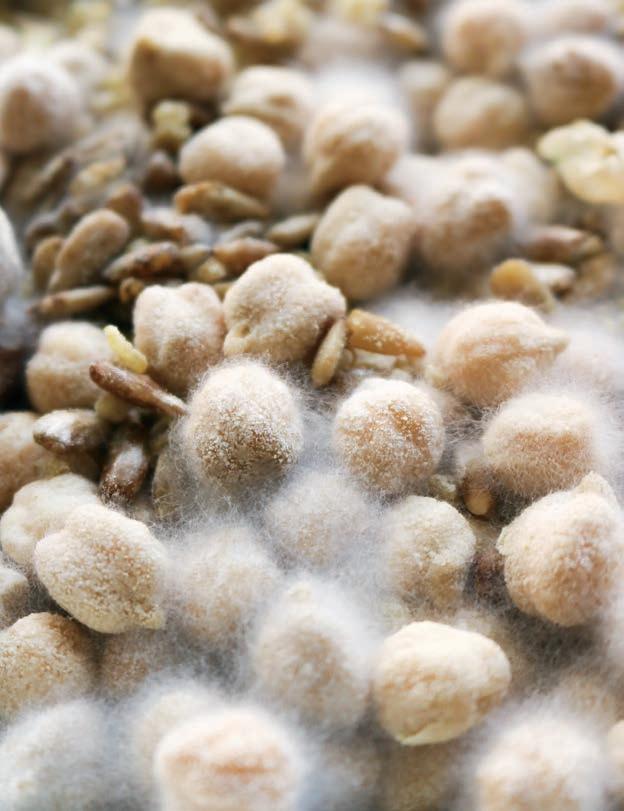

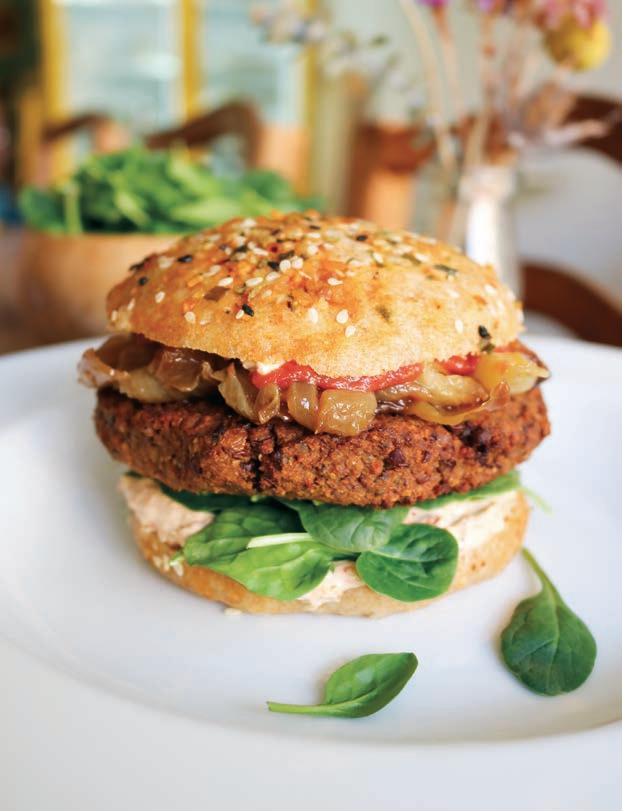
Tempeh is about to hit the big time, if Funky Bean founder Katie Belanger has her way
BY LAUREL MILLER PHOTOGRAPHY BY ANGEL WELCHJust call Katie Belanger the mistress of mold. The owner of Santa Cruz’s Honey B Market is on a mission to raise the profile of nutrient-dense, fermented, plant-based foods and increase their accessibility in the marketplace, starting with fresh tempeh and her new business called Funky Bean.
Traditionally made from cooked, fermented soybeans, tempeh originated on Java and has been a staple of Indonesian cuisine for over 400 years. After cooking, the legumes are inoculated with Rhizopus oligosporus mold (also known as a starter culture), although other mold substrates may also be used. The beans are then wrapped in banana leaves to ferment for a minimum of 24 hours, during which time they form a dense, pungent cake that is bound together by cottony strands of mycelium. The end product has an earthy, mushroom-like quality that holds up well during cooking and can be used in any number of dishes.
With Funky Bean, Belanger is endeavoring to make and sell fresh tempeh. As of this writing, she is the only company in the U.S. to do so. “Commercial tempeh is pasteurized to be shelf stable, but the process also kills off all of the beneficial bacteria and nutrients,” she says. “It also tastes completely different. Until I started making my own tempeh, I didn’t like it because I found the flavor sour and offputting. But fresh tempeh is super umami, with mushroomy, floral notes, depending on what kind of beans you use.”
felt. The more I educated myself, the more I understood that food is medicine.” At the same time, Belanger also started to vacillate between a vegetarian and vegan diet. “I don’t have anything against meat; I just don’t like the way it tastes,” she says.
In 2014 Belanger moved to California, which she thought of as the epicenter of healthy food and wellness, but realized that while there was an abundance of vegan food options, most of them were lacking nutrients. After winning a TV culinary competition that same year, she found herself with the funds to open her first venture, Honey B Market, in Santa Barbara.
The cafe was a hit from the start, and Belanger made a name for herself with her array of sourdough breads and pastries, plant-based spreads, entrées and pickled foods. After the pandemic hit, Belanger decided to shutter the cafe and took a two-month road trip up the West Coast to “study the marketplace” and figure out her next steps. It was around this time that she also began to experiment with making tempeh.
“During COVID, everyone was making sourdough, and I went down the rabbit hole of fermented foods as well. I realized that when tempeh is fresh, it’s a really delicious complete protein. Even when I was eating a lot of eggs, they always left me feeling nutritionally unsatisfied; tempeh changed my life.”
In 2021, Belanger relocated to Santa Cruz after identifying a niche for her particular brand of vegan offerings, and a new iteration of Honey B Market opened on Cedar Street in December of 2022.
To make tempeh, fermented beans are bound together into a block of mycelium and the finished super food contains all nine essential amino acids. It’s also a flavor sponge and can be incorporated into a variety of dishes.
Belanger grew up in the suburbs of Chicago, one of six siblings in a single-parent home. “I had to cook for everyone, and that was the first insight I had into how food unites people,” she says. “But we also ate a lot of processed stuff because it was both convenient and affordable. It wasn’t until I moved out that I realized what I ate had a huge impact on how I
She applied for a wholesale permit when she opened Honey B with the goal of selling her tempeh to local retailers, but she got sidetracked running the cafe. “I was basically a one-woman show and when I finally got my wholesale permit in December of 2023, I decided it was time to put Honey B on pause so I could focus on launching Funky Bean,” she says. “Creating a tempeh brand has always been the goal; it’s such a nutritious, affordable protein.”

Our Daily Bread
Recipe:
100% Organic Flour RO Water
Sea Salt
Attention to Time & Temperature
Skilled Hands Long Fermentation
479 Alvarado Street Downtown Monterey

Eat Some Good Bread Today
“Creating a tempeh brand has always been the goal; it’s such a nutritious, affordable protein.”
While soybeans are traditionally used for tempeh, Belanger avoids them. “They’re problematic for some people because they contain some well-known allergens, and I don’t like using them because they’re the most heavily genetically modified crop,” she says.
Instead, Belanger makes tempeh from adzuki beans, which she says have a higher nutrient density, as well as chana dal, black beans and chickpeas. “Using different types of beans is also a great way to showcase different flavor and texture profiles,” she says. “I find that lighter colored beans like chickpeas tend to have a slightly sweeter, almost fruity flavor, while darker beans are more pungent, although that mellows if you cook the tempeh.”
Fresh, uncooked tempeh isn’t for everyone. Once heated, however, tempeh mellows and takes on more of a nutty quality, with the mycelium acting similar to marbling in meat. “It adds this rich, almost fatty quality,” says Belanger. “It can be used in soups, stews, pan-fried, baked; it’s just so versatile.”
One of the biggest misperceptions about tempeh is that it’s hard to digest, but in fact, the opposite is true. “Beans are an amazing source of protein, but some people just can’t digest them,” says Belanger. “The fermentation process breaks down the bean sugars that can cause gas and bloating, and tempeh actually improves digestion, which is a quality other, more highly processed plant-based foods like tofu and seitan [made from wheat gluten] don’t possess. The more you manipulate a food, the more it changes its nutritional value.”
With Funky Bean now in its early stages, Belanger—who has also written and illustrated a how-to guide called The Little

Book of Tempeh—is working on a line of plain and marinated tempeh and prepared foods like burger patties and hot dogs, all of which are sold frozen. Because tempeh is a living organism, it has a short shelf life (between five and 10 days; frozen it will keep up to one year).
Belanger will also be offering workshops on making tempeh, sourdough, pickling and more, and selling starter cultures and tempeh kits. “I want to normalize making it at home,” she says. “It’s time for tempeh to step into the spotlight.”
Laurel Miller is a food, spirits and travel writer, the associate editor of Edible Monterey Bay, and the former editor of Edible Aspen. She grew up on a California ranch and has been writing about regenerative agriculture for over 20 years. When she’s not tethered to her laptop, Miller enjoys farmers markets and any trip that requires a passport. She’ll take a Mission burrito over a Michelin star, any day.
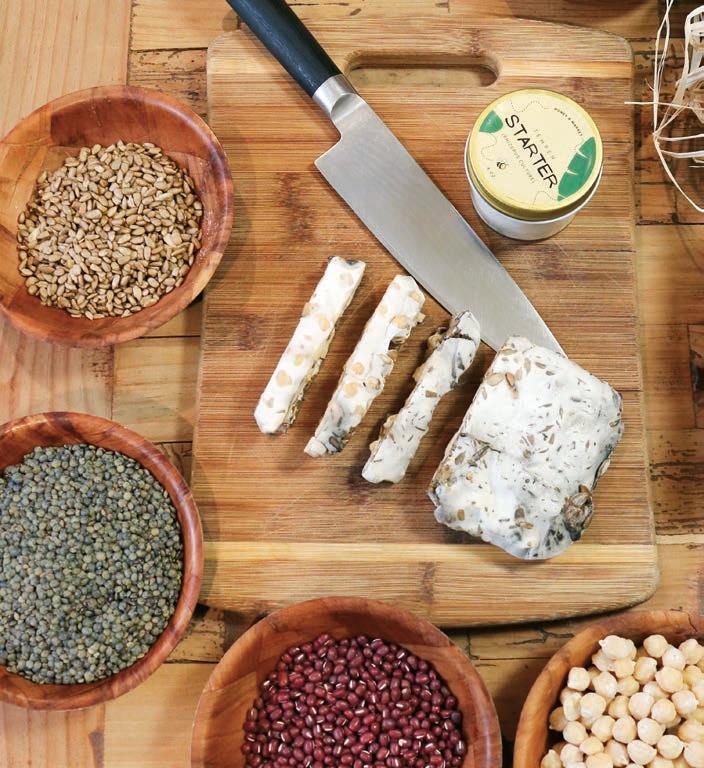
Recipe adapted from The Little Book of Tempeh, by Katie Belanger
1 pound legumes, such as lentils, chickpeas or adzuki beans
2 tablespoons Rhizopus oligosporus culture (available online)
1 tablespoon vinegar, such as apple cider or white wine
1 large banana or ti leaf, available at ethnic food markets, cut into two 12-inch x 6-inch rectangles
Soak beans overnight, then drain.
Cook beans until tender but firm. Drain, and spread on baking sheet to dry.
In a large bowl, mix beans with Rhizopus culture and vinegar, and place approximately ½ to ¾ cup in the center of a banana leaf.
Fold up each side of the leaf, then tie each packet with a rubber band or twine. Place leaf packets on a perforated baking sheet or cooling rack and leave in a warm,


draft-free place for 1 to 2 days. The longer you ferment it, the firmer and denser your tempeh will be. Keep in a closed container in the refrigerator for 5 to 10 days or freeze for up to 12 months. Makes 2.
Tempeh tidbits
• Rhizopus oligosporus feeds best off thin-sk inned legumes like lentils and chickpeas.
• Be sure your workspace and equipment are clean, so the good mold isn’t competing with bad mold.
• Don’t overpack your tempeh bundles; mycelium needs room to grow.
• Tempeh doesn’t like excess moisture, so pat legumes dry before using.
• When wrapping, be sure legumes are completely covered so they don’t dr y out.
• Any black spots (mold) on your tempeh are safe to eat. Avoid consuming tempeh with green mold.


Elderflowers have a captivating, delicate fragrance and flavor that signals summer is on the way.
In our local woods and creekside canyons, the creamy umbels of elderflower begin to flare against the lush green vegetation in late spring. Elderflowers, once pollinated, will eventually grow and swell to become elderberries, and while both flower and fruit are delicious and medicinal in their own right, this is the time of year to celebrate and utilize the flowers that come before the fruit.
In our area, elders appear as a mid-size shrub or small tree, deciduous in winter, leafing and flowering out in late spring, and bearing dark clusters of elderberries in the fall.
Elderflowers have a light, delicate fragrance and flavor that is easily captured in a simple syrup or infusion. You may have tasted it in cocktails like Pimm’s cup, made with the popular St. Germain liqueur.
Grouped in lacy, flat-topped umbels at the tips of branches, the flowers seem to float above the foliage, making easy access for pollinators and foragers alike. But before a forager deigns to pick the delicate blooms, there are some important considerations.
Worldwide, there are many species of elderflower/ elderberry, but the ones we find most commonly growing wild in the Monterey Bay area are the blue Sambucus cerulea and Sambucus mexicana, as well as the poisonous red elder, Sambucus racemosa.
While all members of this genus contain a small amount of cyanogenic glycosides, and therefore warrant
moderate consumption, the red elder has higher levels of cyanide, and is considered unsafe for consumption in either flower or berry form. While there are subtle differences in the foliage that may enable an experienced forager to determine whether the fruit is red or blue, a good general rule would be to only harvest flowers from a plant that is known to have blue-black berries. If you have never seen the color of the summer fruits, don’t harvest the spring flowers!
While the thought of such toxins surely merits caution, it shouldn’t be a barrier to experimentation. The quaint, pure fragrance of elderflowers is worth the care of identification and harvest. It somehow captures the essence of the late-spring season, cool but warming, full of delicate vigor. For those who prefer to forage in a market (or aren’t sure about species ID) it’s possible to find dried elderflowers in bulk at several local health food stores, as well as online.
Once a forager is sure of their identification, the flowers are easy to harvest, having a sturdy central stem that makes picking easy. As with all wild-crafted ingredients, be aware that these flowers are an important source of nectar and pollen, and the berries that will follow the fruits are a reliable food source for birds and mammals later in the season. This resource, like many, is abundant but not infinite, so be respectful of other beings as you plan your harvest.
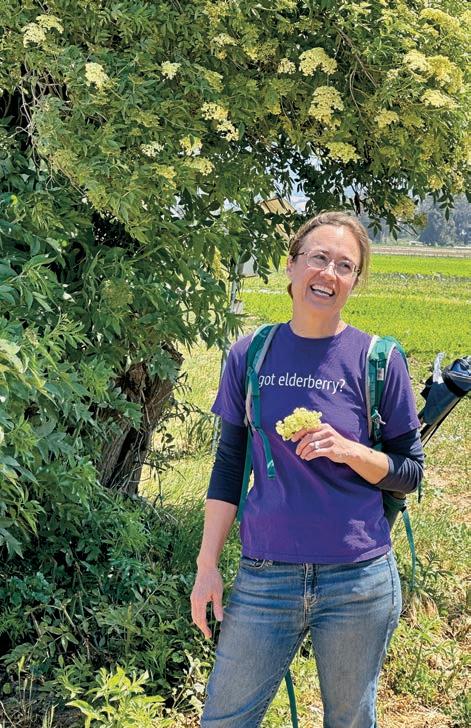
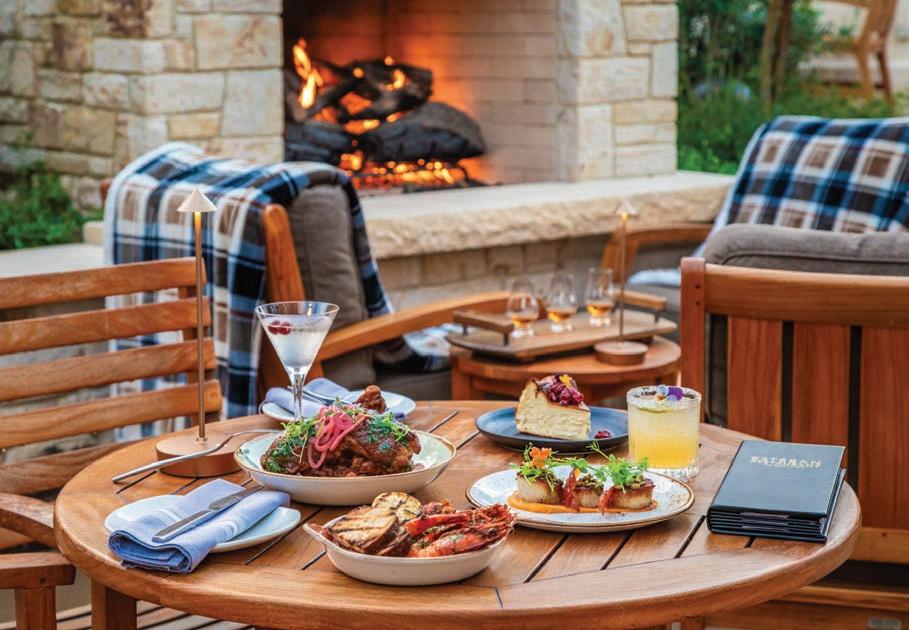
A word of thanks to elder herself might be wise as well; elder is cited often in folklore as a powerful spirit, and it is advised to ask permission before cutting an elder tree, lest misfortune follow.
It’s best to harvest elderflower in the cool morning hours, as heat lessens the delicate fragrance and dilutes its potency. Choose only fresh, young flowers; older flowers that have begun to shrivel will impart a musty flavor.
Give the freshly harvested umbels a little shake, then hang them upside down in a paper bag for an hour to dislodge any bugs that may have made the flowers their home; these flowers are a favorite of many small pollinators. The green parts of the stem and calyx have a bitter flavor that can lead to stomach upset in sensitive individuals, so it’s best to pluck or shake the individual flowers off of the branching green structure of the umbel, removing all of the green parts so that only the tiny white flower is used.
Once your elderflowers are separated from the stem, there are a few favorite, timetested ways to capture their fleeting flavor. In their simplest form, they can be scattered
To learn more about elderflowers and pick some for yourself, join Katie Reneker of Carmel Berry Co., and Nathan Harkleroad of ALBA for an Edible LIVE tour and lunch on Saturday, May 18 from 11am to 2pm. Participants will have a chance to visit elder trees in bloom on the ALBA (Agricultural and Land-Based Training Association) farm in Salinas, learn about the healthful properties of elderflowers and elderberries, and taste foods made with these extraordinary natural ingredients.
over a cake or baked into fritters or pancakes, to showcase both flavor and form, or muddled in cocktails.
The flowers can be dried and used in teas to support the immune system. Because the fresh flowers contain a generous amount of wild yeast, elderflowers can also be used to create a wild-fermented natural champagne—a light, sparkling beverage with a small amount of alcohol from a short (24–48 hour) fermentation.
Alternatively, their flavors can be captured in a simple syrup and used in cocktails, as a base for sorbets, poured over cakes or baked into custards. Katie Reneker, a local elderberry advocate and founder of Carmel Berry Co., has developed a line of elderflower and elderberry products using America-grown elder. Her website carmelberry.com has a wealth of recipes that make use of her own elderflower syrup, for those seeking further inspiration.
Jessica Tunis lives in the Santa Cruz Mountains and spends her time tending gardens, telling stories and cultivating adventure and good food in wild places.
3 cups water
3 cups sugar
3 ounces dried elderflowers or 4 tablespoons fresh elderflowers, stripped from the stem, green par ts removed
½ teaspoon citric acid (optional)
1 lemon, sliced
Make a 1:1 simple syrup, heating the water and stirring in the sugar until dissolved. Place the destemmed elderflowers in a quart-size jar. Add citric acid, (if using) and
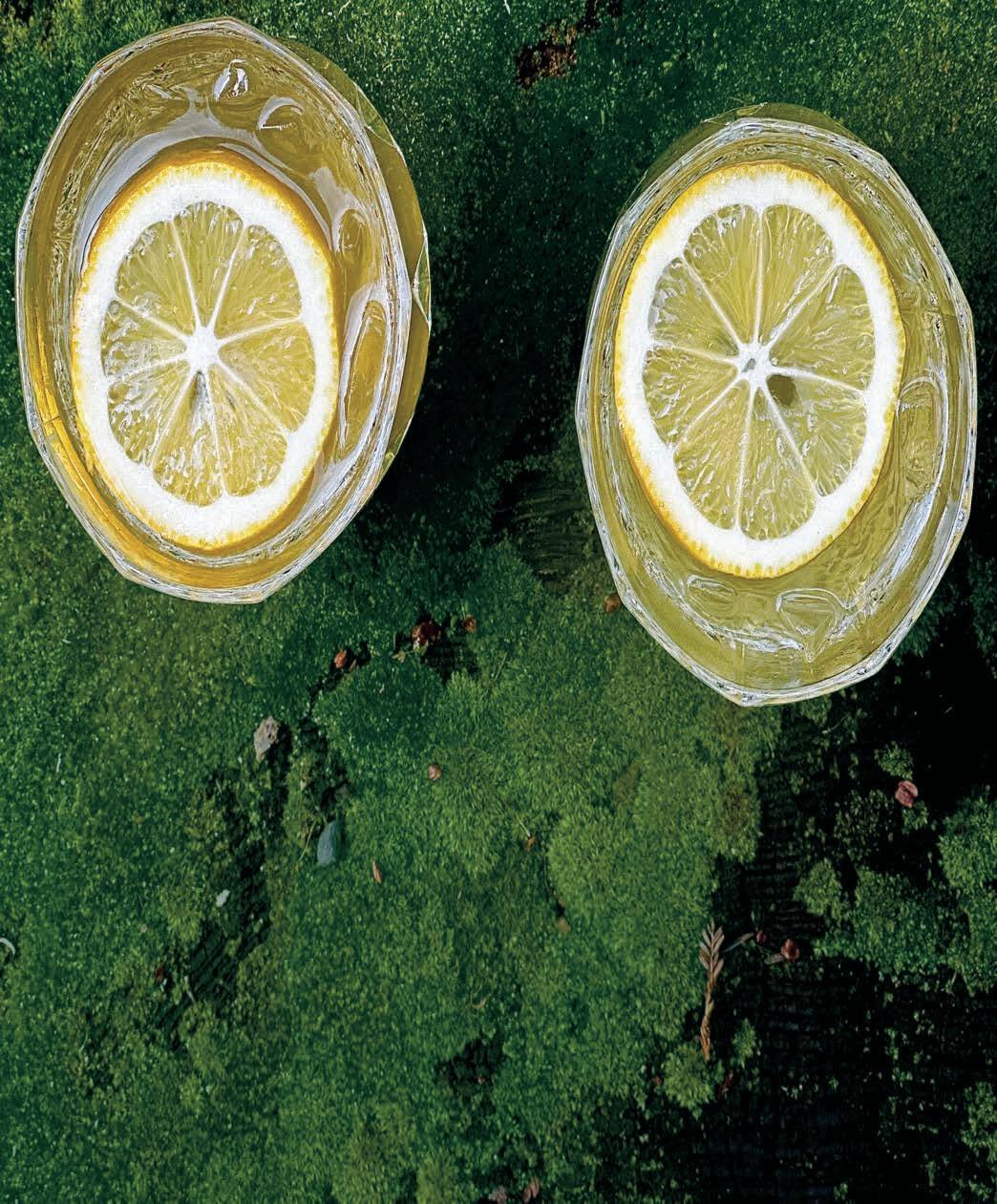
sliced lemon. Syrup made without citric acid will not keep for more than a week without fermenting; the addition of citric acid makes it keep longer.
Once the syrup has cooled, pour it over the elderflower mixture. Allow this to infuse in the fridge for 24–48 hours; any longer may induce fermentation due to the presence of wild natural yeasts on the elderflowers. Strain the flowers and lemon from the syrup. Store in a clean quart-size jar or clamptopped jar. Makes 1 quart.


½ ounce elderflower syrup
8 ounces sparkling water
Dash of aromatic bitters
Lemon and/or fresh flowers, for garnish
Fill a Collins glass with ice. Add syrup. Top with sparkling water and a dash of bitters. Garnish as desired. Makes 1 mocktail.


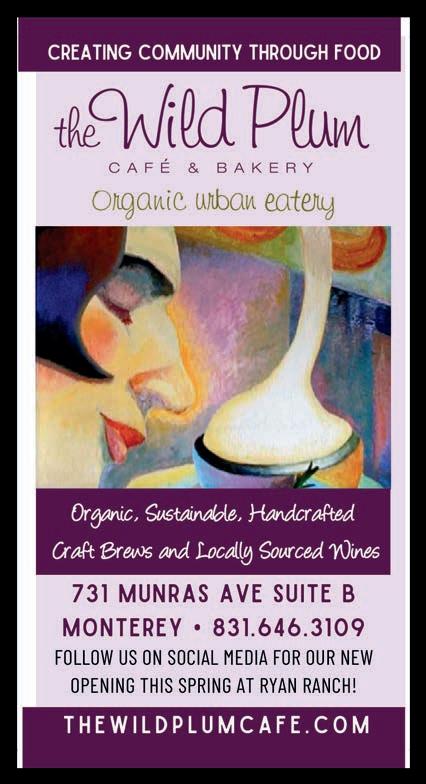
Apricots* • Avocados • Blackberries* • Cactus Pears* • Grapefruit** • Kumquats**
Lemons • Limes** • Mandarins** • Oranges • Pomelos** • Rhubarb** Strawberries
Artichokes • Arugula • Asparagus • Beets • Bok Choy • Broccoli
Broccoli Raab • Brussels Sprouts • Burdock • Cabbage • Cardoons • Carrots
Cauliflower • Celeriac*** • Celery*** • Chard • Chicory • Collards • Cress
Dandelion • Endive • Fava Beans and Greens • Fennel • Garlic • Horseradish
Kale • Kohlrabi • Leeks • Mushrooms • Mustard Greens • Nettles • Onions
Orach • Parsnips • Peas** • Pea Shoots • Potatoes • Radishes • Rutabagas**
Shallots • Spinach • Sprouts • Squash • Sunchokes • Turnips
Abalone • Crab, Dungeness • Grenadier, Pacific • Halibut, California* • Lingcod, Pacific • Rock Cod, aka Snapper or Rockfish • Sablefish, aka Black Cod Salmon, King • Sanddabs, Pacific • Seabass, White • Sole (Dover and Petrale) Spot Prawns • Squid
* May only ** March and April only
***April and May only
All fish listed are rated “Best Choice” or “Good Alternative” by the Monterey Bay Aquarium’s Seafood Watch program and are found in abundance in local waters. See seafoodwatch.org for more information.




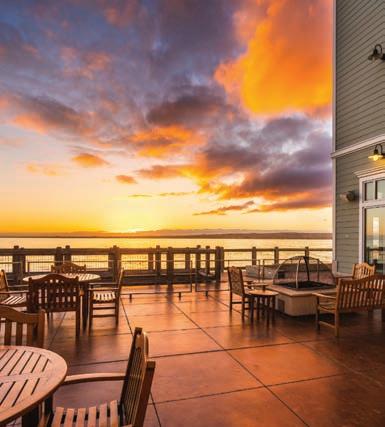




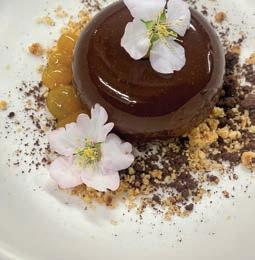
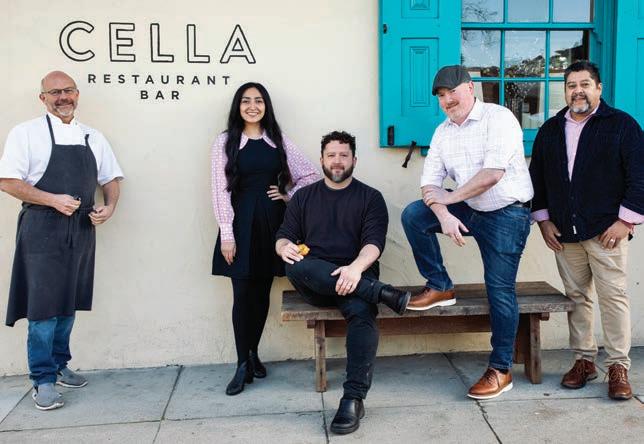


Chef Nick Sherman is a busy guy. He helms his popular Capitola Village restaurant, Trestles, which opened in 2021. He also just launched a sister restaurant Cavalletta, with a Cal-Ital slant and amazing wood-fired pizza, in Aptos.
As hectic as his schedule is, Sherman took the time to generously share a spring gnocchi recipe with us, perfectly suited for the season and surprisingly easy to make at home.
“This recipe is nice because you can make it a day or two ahead of time and keep it in the refrigerator. Or you can freeze the gnocchi before the boiling stage. It’s really great to have some on hand

in the freezer for a later date,” he says.
The recipe is also very versatile and adaptable for any season. You could, for example, incorporate winter squash or wild mushrooms in the colder months, or add corn in the summer. This spring, Sherman is featuring these gnocchi on his menu at Cavalletta, with a variation of the pesto if not the same version.
“Spring is rad because you can use a bunch of veggies in different ways, like pea shoots or fava leaves in the pesto instead of the arugula. You can throw anything in there. That’s the beautiful thing about pasta; you can add depth of flavor with different ingredients so easily.”

Chef Nick Sherman—who runs both Trestles and Cavalletta— adapts his gnocchi dishes to whatever vegetables are in season.
2 tablespoons extra virgin olive oil
Ricotta gnocchi (recipe follows)
2 cloves garlic, thinly sliced
Pinch of chili flakes, or more if you like spicy (optional)
1 cup English peas, blanched and cooled
2 cups asparagus, cut into 1-inch sticks, blanched and cooled
1−1½ cups vegetable stock or water
3 tablespoons butter
½ cup grated Parmigiano Reggiano
Arugula pesto (recipe follows)
Salt and pepper, to taste
1 tablespoon fresh lemon juice
10 cherr y tomatoes, halved, for garnish (optional)
4 tablespoons pine nuts, toasted, for garnish
Shavings of Parmigiano Reggiano, for garnish
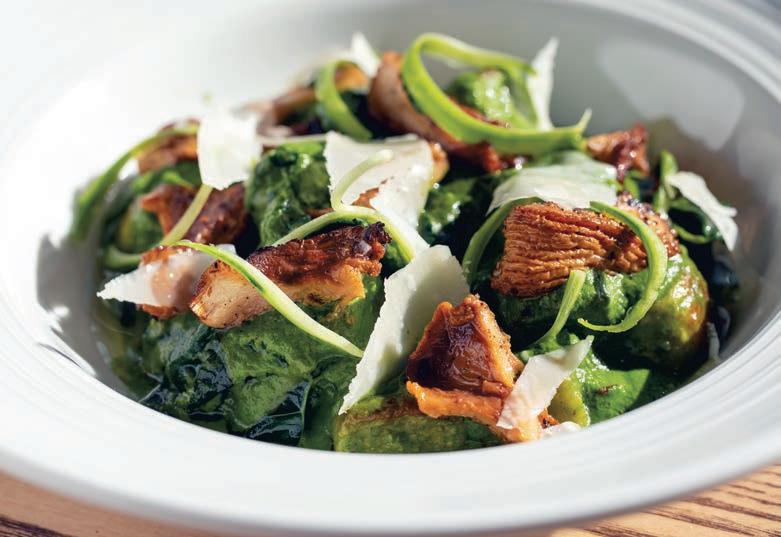
In a large nonstick sauté pan, add the EVOO and bring up to medium heat until hot. Add the gnocchi and cook until caramelized on one side.
Flip the gnocchi, add the sliced garlic and cook until the other side is caramelized.
Add the chili flakes, peas, asparagus, half of the vegetable stock or water and butter. Lower the heat and reduce the sauce slowly without cooking all the stock or water out so the butter stays creamy.
Add the Parmesan and the pesto and stir to combine. Season with salt, pepper and lemon juice to taste. If the sauce is too thick, add more of the vegetable stock to desired consistency.
Place in a bowl for serving and garnish with cherry tomatoes and toasted pine nuts. You can also top with some freshly shaved Parmesan and a drizzle of EVOO, if desired. Serves 6−8.
For the ricotta gnocchi
2 pounds dr y ricotta (it typically comes in 15- ounce containers, so get 3 and weigh out 2 pounds)
2 large eggs
¾−1 cup all-purpose flour
2 tablespoons salt
Pinch of ground nutmeg
In a large bowl, beat eggs then add the ricotta and mix well. Add ¾ cup flour, nutmeg and half the salt. Combine well. If too sticky, add the remaining ¼ cup flour. Check for seasoning and add up to another tablespoon of salt if needed.
Roll the dough on a floured surface with your hands into a cylinder shape about the height of a quarter. Cut into 1-inch pieces with a sharp knife.
In a large pot, bring salted water to a boil. Add half of the pieces of gnocchi and blanch for 2 minutes or until they float to the surface. Remove gnocchi with a slotted spoon or strainer and place in a container to cool. Repeat with remaining gnocchi.
Let cool down at room temperature, then toss in a little bit of extra virgin olive oil and refrigerate until ready for use.
For the arugula pesto
3 light handfuls arugula
2 light handfuls spinach
3 cloves garlic, chopped or grated Zest of 2 lemons
¾ cup extra virgin olive oil
½ cup Parmesan, grated
¼ cup pine nuts, toasted Salt and pepper, to taste
In a pot of boiling water, blanch the arugula and spinach until tender, about 1 minute. Immediately remove from water with a slotted spoon or strainer and place greens in an ice bath until cold.
Squeeze most of the water out of the spinach and arugula into a bowl, and save it in case the blender needs more liquid to blend. Place all the pesto ingredients in the blender and process until it’s a smooth paste. If the blender does not get it fully puréed, slowly add more of the cold water until it binds.
Tips & Tricks:
• Use really dry ricotta in this recipe, similar to the texture of goat cheese. If your ricotta is not dry enough, line a strainer with cheesecloth and add the cheese. Wrap the cheesecloth over the top and put some weight on it. Place in the fridge overnight to drain.
• We make our own ricotta for this dish but you can use Bellwether Farms ricotta, which is a good brand.
• The reason we use some water in the pesto is so we have a brighter, cleaner flavor, much lighter on the palate than a super oily, traditional pesto.
• It’s important to use authentic Parmigiano Reggiano for this recipe. Other kinds of Parmesan will not melt into the sauce properly.



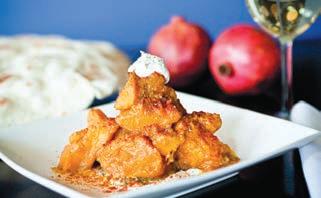











The first peek of spring is always welcome. For those living in icy climes, it must feel like a promise from nature of warmer days ahead. For us here in the Monterey Bay area, a glimpse of green isn’t a revelation. The hills are already bursting with bright green by
Tuesday
Felton Farmers Market
1–6pm • May through October
120 Russell Avenue • 831.454.0566 santacruzfarmersmarket.org
El Mercado
2–6pm • April through October
Park, Watsonville 831.726.4257 • pvhealthtrust.org
Wednesday
1–6pm


Friday
January. But let’s not undermine our own seasonal shifts. We can still rejoice that the first signs of spring have come, with the scent of new blooms, the crisp peas and the tender leaves…and never forget our early strawberries, truly the sweetest spring gift there is.
—Amber Turpin
facebook.com/watsonvillefarmersmarket
Scotts
Corralitos


Monday
Pacific Grove Certified Farmers Market
3–6pm • Year-round Central and Grand Avenues 831.384.6961
everyonesharvest.org
Tuesday
Carmel Barnyard
Certified Farmers Market
9am−1pm • May through September
3690 The Barnyard 831.728.5060 • montereybayfarmers.org
Old Monterey Marketplace & Farmers Market
4–7pm • Year-round Alvarado Street • 831.655.2607 oldmonterey.org
Wednesday
Natividad Certified Farmers Market
11am−3:30pm • May to October
1441 Constitution Blvd., Salinas 831.384.6961 • everyonesharvest.org
Hollister Certified Farmers Market
3−7pm • April 17 to October 16
San Benito Street between 5th and 7th 831.636.8406
downtownhollister.org/farmers-market
Thursday
Carmel–by-the-Sea Farmers Market
10am–2pm • Year-round 6th and Mission Streets 831.402.3870 • goodrootsevents.com
Castroville Farmers Market
3−7:30PM • Year-round
Castroville Recreation Center 11261 Crane Street ncrpd.org
Seaside Certified Farmers Market 3–7pm • Year-round
Laguna Grande Regional Park 1259 Canyon del Rey Blvd. 831.384.6961 • everyonesharvest.org
Soledad Certified Farmers Market 4−8pm • April to October
137 Soledad Street • 831.678.3504
Friday
Monterey Certified Farmers Market
8am–noon • Year-round
1410 Del Monte Center 831.728.5060 • montereybayfarmers.org
Salinas Valley Health
Certified Farmers Market
12:30−5:30pm • May to November
450 East Romie Lane 831.384.6961 • everyonesharvest.org
Saturday
Old Town Salinas Farmers Market
9am–2pm • Year-round
300 block Main Street 650.815.8760 wcfma.org/salinas
The Power Plant
Certified Farmers Market
9am–2pm • Year-round
7990 Highway 1, Moss Landing 831.453.0022
thepowerplant.store/farmers-market
Sunday
Carmel Valley Certified Farmers Market
10am–2pm • Year-round Mid-Valley Shopping Center
550 Carmel Valley Road 650.290.3549 • wcfma.org
Marina Certified Farmers Market
10am–2pm • Year-round 215 Reservation Road • 831.384.6961 everyonesharvest.org














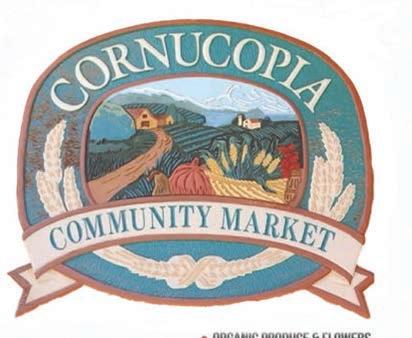
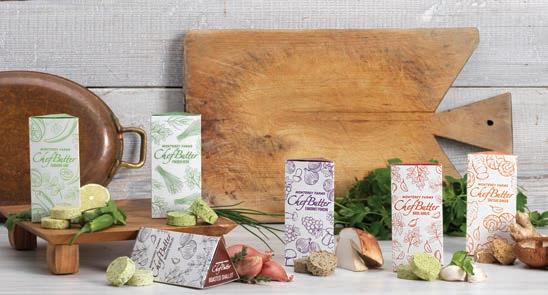








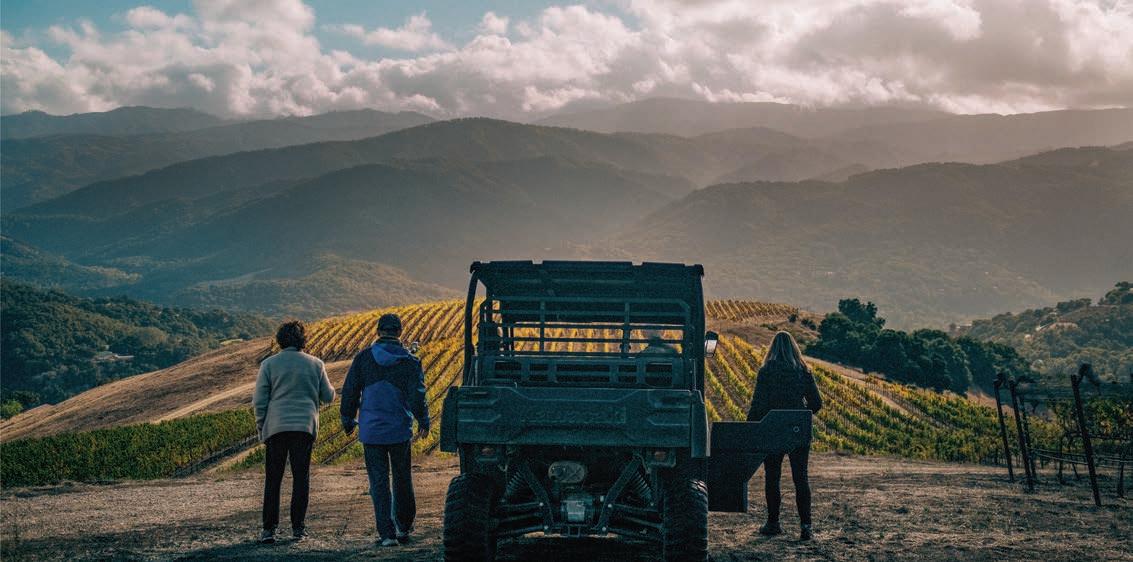

Jerid Rold was asleep on The Aquatic, a 72-foot steel schooner his father built, when the crew landed the first catch of a twomonth albacore expedition to Oregon.
“It’s my first crazy-vivid memory, waking up to fish flopping on the back deck,” he says. “I could smell it in the air.”
Rold was five at the time. He would turn six at sea.
Flash ahead a few decades, and Rold’s eldest kid, Sparrow, leads the would-be fifth generation of Rold fishers.
Like his dad, he appears young and smiling wide in photos taken aboard family boats, cradling fish as big as he is, stoked to carry on a family calling.
Only that’s no longer likely.
“I talk to my kids about fishing, about what it was like, how hard we worked, how they should appreciate the life they have today,” he says. “But I don’t try to get my kids to want to fish, and not because I don’t love fishing.”
Rold knows enthusiasm doesn’t override the undertow of challenges. In just the past year Monterey Bay fishers have endured a canceled salmon season, delayed Dungeness crab season, various ground fish closures and many other sticks in the spokes—some economic, some global, some regulatory, some oceanic
and all ongoing—conspiring to make it almost oxymoronic for him to fish for a living
So, like a growing number of fellow fishermen, he is adjusting course.
Rold chose microgreens as a more mindful tack, and now grows his own Mojo brand radish, broccoli, kohlrabi, kale, cilantro and leek greens in his garage, with help from the kids.
He sells them at the Aptos and Del Monte Center farmers markets, and to restaurants like The Sardine Factory and Woodward Marine, reinvigorating relationships from his seafood-slanging days.
“It doesn’t pay like fishing,” he says. “But I’m lucky to have a wife with a good income, and this allows us to, hopefully, save our house. I feel like I’m finally building a business that can have a future.”
Rold is unafraid to wade into policy discussion, and has been calling for more responsive management decisions for decades. It’s more fun to hear him reminisce about spotting his first sharks, hunting squid by bright night lights or peering out the wheelhouse window as the rolling Aquatic leaned like a rocking chair toward the surface of the sea.
His favorite onboard activity as a kid was loading the smaller albacore he could heft, just high enough, into the conduit connecting to the fish bay below.
A generation later, many local fishers like him feel they’re heading down the chute, to a place where independently owned fishing boats become a fond but faraway memory.

This story hooked me by surprise.
I was helping local seafood subscription service Real Good Fish (RGF) and Monterey Bay Fisheries Trust (MBFT) compose profiles of their partner fishermen when RGF co-founder Alan Lovewell pointed out how quickly their lists were growing stale.
He ticked off names still visible on the respective websites and no longer active in the craft, saying something to the effect of, “He’s now a fireman, those two retired, and David’s a mechanic.”
The last one landed with a thud.
David Toriumi represents the rare younger local fisherman with his own boat, and also a thoughtful voice active among solutioncentric groups like the Monterey Bay Fisheries Trust, the Monterey Bay Salmon and Trout Project, and the Pacific Fishery Management Council, sharing on-the-water insight to inform fishery decisions.
Or at least he did.
“I got a lot of connection with the community through harvesting fish and crab, and engaging in policy was protecting a way of life,” Toriumi says.
I traveled to his auto repair shop in Watsonville to better understand.
A few steps away from the waiting room, hung with photos of Toriumi hauling in a huge salmon, he orchestrated a thrum of activity, fielding customer calls, directing employee duties, peering under the hood of a custom Chevy Impala SS.
Toriumi's mission ashore happened in part for personal reasons, including the sudden loss of his dad to a heart attack, which left a
vacuum in the family and at the shop.
But young Toriumi had pre-existing conditions his fellow fishers know well—he notes the sheer number of commercial crab and salmon permits for sale as an indicator—that led him to leap at a fresh chance for survival.
“I don’t have the [luxury] of going bankrupt,” he says.
While departures like Toriumi’s mean consumers lose some access to local protein and many fishers will struggle, plenty will find a way forward.
“When forced to leave, they’ll be successful—you can’t be a fisher without being entrepreneurial and multitalented,” Lovewell says. “You need to be adaptable. If they can’t fish, they’ll turn to the land.”

Throaty harrumphs of a sea lion chorus bounce off the mild morning sky above Monterey Harbor.
Jiri Nozicka stands on the wood-hulled San Giovanni, the oldest active fishing boat on Monterey Bay, unspooling a love story.
“My first time on this boat, we didn’t catch much, but we caught more than I’d ever seen,” he says. “That’s when it happened: I thought, ‘I could do this. This is beautiful.’”
The Czech native fell for the work (“There’s a very big tradition with the boat’s family and the community,” he says), then the boat (“a piece of art”), then the captain’s daughter Elizabeth. Her dad, local legend Giuseppe Pennisi, eventually turned over the San Giovanni
Now Nozicka can’t quit fishing, despite what he calls, professionally speaking, “death by 1,000 stabs.”
Some of the daggers involve costs for boat fuel, truck fuel, life fuel, ice, maintenance, offloading fees and governmentrequired monitors that make for overhead steep enough that he does all the sales, delivery and fish processing himself.
He can’t afford much help there, even if he could make the gig steady enough to retain support.
“He doesn’t sleep much,” his eldest son Ladi says. “But he still gets so excited to go out.”
On occasion the grind means three separate trips to San Francisco in a day, wherein Nozicka rotates between his wife and sons as companions to keep him awake.
And those are only the amuse bouche obstacles, a teaser for the longer menu of tests to endure.
Those include competitive disadvantages against cheap imports and aquaculture; sale prices artificially depressed through market manipulations by powerful corporate buyers; a target audience often unaware of or unwilling to try alternatives to salmon, shrimp and tuna; threats from offshore wind development; and ever-shifting regulation to protect—in ultimately helpful ways—species like rockfish, salmon (a wildly complex
conundrum on its own) and humpback whales (which shortens crab seasons and presents another decision maze).
That all grows more complicated with the ongoing chaos of warming oceans, across a Monterey Bay ecosystem defined by variability in its two foundational species, anchovies and sardines.
The difficulty drives Ocean Conservancy’s Corey Ridings, a longtime sustainable fisheries pro who serves on the Pacific Fishery Management Council, toward systemic solutions.
“We all want a silver bullet to help solve things,” she says. “But to have successful small-scale fisheries, we have to address all of those problems. It would be really nice if there was just one smoking gun we had to find. Instead we’re dealing with a manyheaded hydra.”
Back at the harbor, Nozicka’s gaze drifts from the vessel he’s gradually rebuilt plank by plank to the nearby docks, which are packed with sailboats and other recreational watercraft.
“When I started, 90 percent of this was fishing boats,” he says. “I speak to my oldest son about how he can grow [this business], but do I really want him to go through it? It’s almost a miracle we’re doing what we’re doing now.”
From 1980 to 2008, studies conducted by the National Marine Fisheries Service show the number of commercial vessels landing fish at Monterey Bay ports dove from more than 1,400 to fewer than 150.
“Now we’re down to maybe 20 boats,” Nozicka says, a number the Fisheries Trust confirms.
Meanwhile Nozicka—who says, “I used to be the up and comer, now I’m the old guy”—epitomizes demographic data gathered from a National Oceanic and Atmospheric Administration (NOAA) survey of more than 1,400 West Coast fishers.
The latest survey found the biggest age group represented among respondents is 60–69, at more than a third. Older than 50 accounts for around 75%. Less than 3% report as 18–29 years old.


It would be really nice if there was just one smoking gun we had to find. Instead we’re dealing with a manyheaded hydra.”

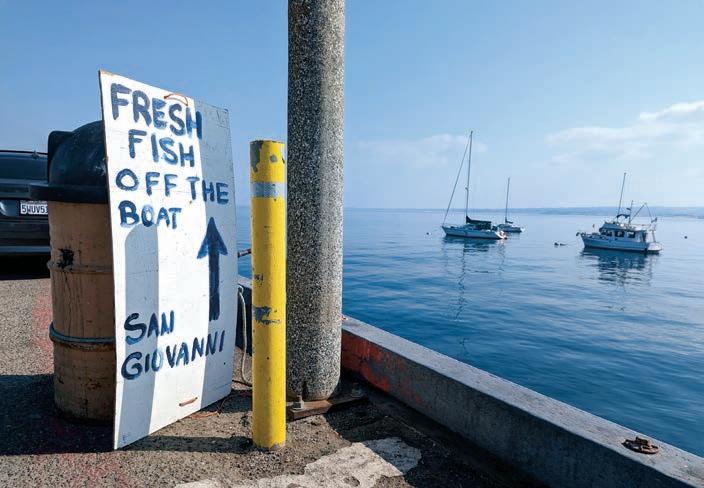
Other survey insights found roughly 75% of respondents earn non-fishing income; nearly 65% report effects from fishery closures; and 69% have had to adjust strategies in response to environmental change.
Then the kicker: More than 94%, across all age groups, report they’d rather fish than do anything else.
Nozicka used to teach an environmental economics seminar at CSU Monterey with Richard Parrish, a longtime fisheries biologist with NOAA and the National Marine Fisheries Service.
Parrish flags an additional blinking-red threat to the local fisher-person populations.
“A lot of organisms have critical habitat that’s really important to protect—birds have the Farallon Islands, for instance—for fishermen it’s marinas and shore processing facilities,” he says. “You close down too many fisheries, and all shore facilities go bankrupt. These days you can’t land fish in Monterey and get them fileted.”
Fisheries Trust Executive Director Melissa Mahoney also emphasizes industry framework.
“Once the infrastructure, fishers, the vessels, the commercial harvest go, they’re gone—and we’re effectively living that now—and then they’re very hard to get back.”
Still, if you listen closely enough, resilience remains audible in Novicka’s voice.
“We’re trying to resurrect something, and it’s not going to be a beautiful phoenix out of the ashes,” he says, a wry grin mirrored on the water. “Maybe it’ll be a little chicken that lays a few eggs.”
When I mentioned the working title of this piece (“RIP Local Fishermen”) to one West Coast fisheries expert, the source replied with an analogy.
“Is the Monterey Bay [fishery] a dying patient?” the source asked, on condition of anonymity. “If so, are we trying to make everyone comfortable, or truly trying to help the patient recover?”
Later I shared those thoughts with Mahoney, who understands the stakes, and provides perspective.
“The bottom line is people need to eat, and want great local food,” she says. “We expect government and market forces to do the things we need to maintain that access, but those things have gotten out of balance and communities need to show up.
“Current realities are not a death sentence,” she adds. “They’re a call to action.”
Mark C. Anderson is a roving reporter, photographer and explorer who won best magazine column at San Francisco Press Club’s Journalism Awards this winter.



Pelicans swoop past, wings steady. Otters drift by, paws busy. A big bernadoodle and a scruffy little mutt make acquaintances, tails waggy.
Meanwhile, tourists and locals occupy picnic tables on decks overlooking Elkhorn Slough. On colorful plates appear some of the coast’s best (and most generous) Baja fish tacos, and its freshest calamari (because it’s caught and cleaned locally, unlike so much shipped to China for cheaper treatment).
The scene at Sea Harvest Fish Market & Restaurant in Moss Landing emits happiness on its surface. Beneath the surface lurks hope.
The short version of the family business: Daniel and Richard Deyerle started catching sand dabs as teens, selling them in buckets to Italian-American fishmongers, then kept fishing when they weren’t surfing.
In June 1982, those ocean-going brothers opened a modest Sea Harvest market on Foam Street in Monterey, which—with patient investments born of lucrative Alaskan expeditions—expanded to fill the building with a full-blown restaurant and bigger dreams.
“Fishing was a thriving industry in California at the time,” Daniel says.
With the help of brother number three (David), the Deyerle family gradually added outposts in Carmel and Salinas, the latter of which they sold to a store manager.
Meanwhile, over time, they focused on fundamentals like boats, a processing facility and an industrial ice machine they now share with local partners in Moss Landing, for free.
Last December, the Deyerles opened their own no-frills dockside seafood shop to complement their boats, markets and restaurants, stocked with catch from their own team.
“It doesn’t get fresher than that,” third-generation fisher Walter Deyerle, Richard’s son and captain of the F/V Sea Harvest IV, said when it opened. “Today I put fish in the bins still flopping.”
On a January visit, these ice bins present fresh sea scallops, black cod, rock cod, whole long spine thorny heads, Dungeness crab and hand-prepped calamari, all adjoining a cavernous processing bay and industrial size walk-in refrigerators as big as racquetball courts.
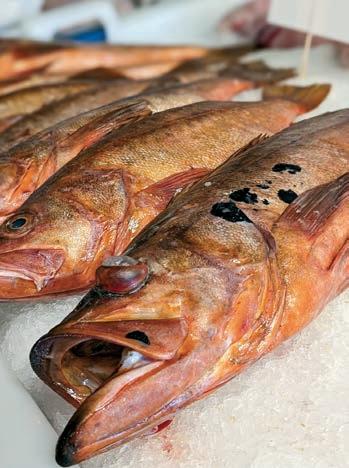
Walter knows the family can’t compete with low prices from giant operations enjoying contracts with big supermarket chains. But they can have fresher product handled by longtime staffers for a comparable price, in house.
As this goes to press, Moss Landing market manager Andrés Jacobo just started circulating a direct-to-consumer messaging service, alerting consumers to the incoming haul via text.
Adaptations like that—and fisher-driven dockside sales—are crucial.
“One of the things I find hopeful is that I’m seeing real willingness and interest in finding new ways to sell fish and engage with consumers— and the regulatory process too,” says NOAA economist Cameron Speir. “To see the real enthusiasm to move the industry forward bodes well.”
Simplifying the supply chain works as the operating ethos for community supported fisheries like Real Good Fish and Ocean2Table, and area markets like Sea Harvest and H&H Fresh Fish Co. next to the Santa Cruz Harbor.
“I believe in the ocean’s ability to feed people, and a lot of them, with a lot of healthy food that’s more sustainable than most on the planet,” Real Good Fish’s Lovewell says, “I believe people have an inherent connection to the ocean. It’s there for us. It provides. We just need to take care of it.”
Local fresh fish subscriptions invite a willingness to eat with seasonality and adventure, an approach the Monterey Bay Fisheries Trust also elevates.
Its website provides a reservoir of resources on which local species merit attention, how to find them and ways to prepare them, alongside updates on trends, rules and realities facing local fishers and the area’s marine ecosystem.
When it comes to realities—then and now—Daniel Deyerle offers a closing note.
“We started fishing so we didn’t have to work for anyone, you know, go surfing in Baja, have an adventurous life,” he says. “But we ended up working harder and longer than anyone. So I don’t know what the trade-off is.”


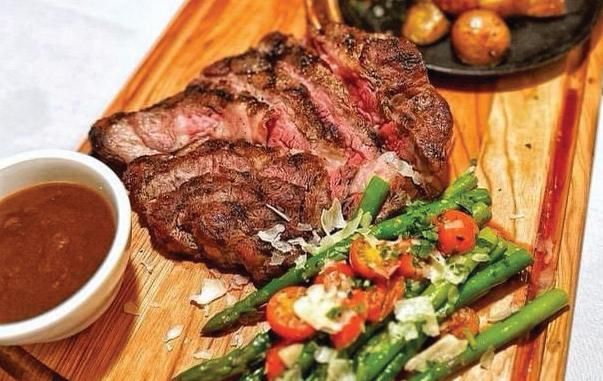


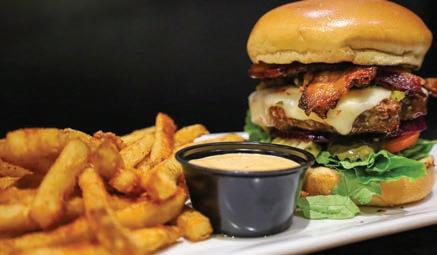




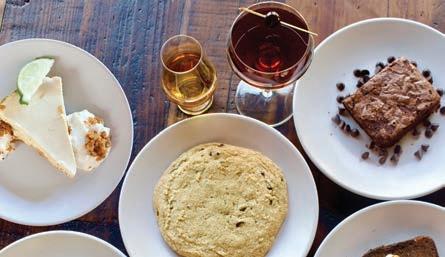



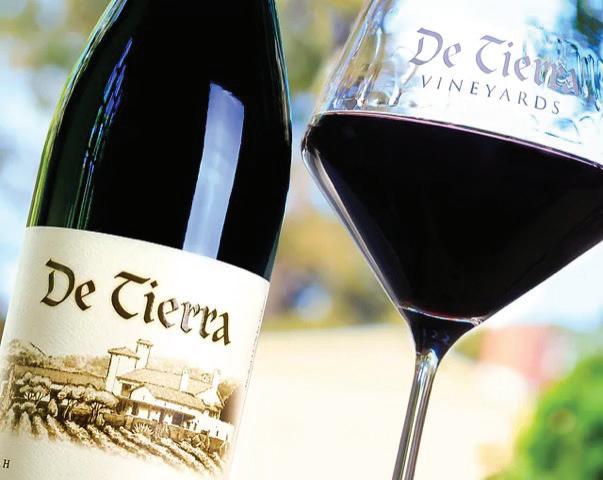





Cuisines love dialogue. That is precisely how the fabric of our tablecloths is woven, through exchanges among people, navigating generations and continents.
Discovering something new, and somehow making it our own, is how we build identities.
Therein lies the reason why defining authenticity can be tricky. Especially when you are staring at a grocery shelf where two apparent strangers with similar looks— Chinese chili oil and Mexican salsa macha—might be closer than a whole ocean apart.
For 250 years during Spanish colonial times, Mexico had a fascinating exchange with Asia. Spanish trading ships known as Manila galleons carried goods back and forth across the Pacific to the port of Acapulco, then merchandise traveled across Mexico and left for Europe from Veracruz, on the Gulf of Mexico. That’s how ingredients so ingrained in Mexican cuisine like limes, cilantro, tamarind, mango, and sesame were embraced, alongside techniques like ceviche. And Asian spices like clove, star anise and cinnamon were adopted in dishes like mole poblano. Ginger, although navigating on the same boat, never gained popularity.
The China ships also carried goods back to Asia, among them tomatoes, chocolate and the widely welcomed chiles. Chiles arrived in China around 1570 and were embraced at the table and for medical use. They were finely chopped and placed in oil to preserve them, and the rest is history.
There are as many versions of salsa macha as proud grandmothers claiming theirs as the original version.
Chili oil has become one of the most widely used condiments, as well as an ingredient in recipes. It can go from a bright red, light oil to a dark, dense paste. Oil is a perfect vehicle for flavor, so it’s important to choose a neutral base like peanut oil or corn oil. In its most basic form, warmed oil is poured over chili flakes and in some cases, other ingredients. But it gets exciting as you build layers of flavor by infusing the oil with aromatics like garlic, ginger, herbs and spices, and of course, Szechuan peppercorns. It is very easy to prepare, and the results are stunning.
Combine chili oil with peanut butter or ground sesame, lime juice and a tablespoon of honey to make a perfect sauce for noodles, grilled chicken or seafood. Toss with cucumbers, cabbage, carrots, soy sauce and rice vinegar for a quick salad. Marinate mushrooms in it before grilling, or use it to add interest to a cream sauce. The possibilities are endless.
Salsa macha, chili oil’s Mexican cousin, is also an oil-based sauce, which is remarkable because pre-Hispanic people did not use oils in their cuisine. But there were salsas made of coarsely ground dried chiles in the Veracruz region, one of the main pathways for Asian trade. So at some point the addition of oil and seeds must have made perfect sense, since they were part of the goods traded. It’s one of the few Mexican salsas that does not include fresh ingredients, so it traveled well.
There are as many versions of salsa macha as proud grandmothers claiming theirs as the original version. The name comes either from macho associating it with bravado for its spiciness or machacada, roughly crushed, for its texture.
It’s best made with mild olive oil in which ingredients are fried gently and then coarsely ground together. Salsa macha gets interesting when a mix of dried chiles is used, but morita, a dried chili from Veracruz, is essential. Touches of acidity and sweetness are important for added complexity. Some versions use fried tortillas for body, or unexpected ingredients like plums, hibiscus, apricots and even mezcal. Garlic can add flavor to the oil, but unless the salsa is used promptly, it is better to remove garlic to prolong shelf life.
Salsa macha is perfect over roasted carrots with tahini, baked sweet potatoes with goat cheese, in fact, anything with cheese. Use it to top baked salmon, shrimp or your favorite seafood, over fried eggs, soups and anywhere chili oil is welcome to join the party.
Over the centuries there have been other waves of Asian migration to Mexico, some leaving larger traces than others, like grilled jalapeños blending seamlessly into sushi. The lines tend to blur as time rolls along.
It’s all about what lands on our plate, regardless of origin or labels. I say a dish is authentic the more it resembles what your memory retains as the perfect bite, even better if it’s part of a moment you remember dearly.
Analuisa Bejar loves exploring flavor routes as the chef at her Sunny Bakery Cafe in Carmel Valley. She is a recent transplant from Mexico City, where she was a food critic, award-winning writer, editor, recipe developer, culinary teacher and the organizer of a Latin American gastronomy competition.


This is a basic recipe on which you can build layers of flavor. Play with the aromatics by adding cardamom, lemongrass or lime leaves as they do in other Asian countries. As for the chili flakes, it’s nice to include both fine and coarse textures. Korean gochugaru is milder and balances out the fiery coarse chili flakes found in Asian markets. This combination can be enriched with soy sauce, fermented soybeans, sesame seeds or oil, garlic, crisp shallots and even honey. Just keep in mind the addition of fresh ingredients will shorten its shelf life.
1½ cups vegetable oil
3 cloves garlic, smashed
1 spring onion, cut into chunks
1 2-inch-long piece orange peel
4 slices ginger
3 pieces star anise
2 bay leaves
¼ red onion or shallot, cut into chunks
1 cinnamon stick
3 cloves
1 tablespoon Szechuan peppercorns
8 sprigs cilantro
For the chiles
1/3 cup fine chili flakes (Korean gochugaru)
1/3 cup coarse chili flakes
½ teaspoon salt
½ teaspoon brown sugar
Combine oil and all aromatic ingredients in a saucepan or heavy wok. Warm gently over low heat for about 15 minutes. As the temperature rises, the oil will bubble lightly. It should not sizzle or brown ingredients.
Meanwhile, place chili flakes, salt and sugar in a heatproof bowl.
When oil reaches 330º F or is bubbling enthusiastically, remove from heat and allow to cool down for a minute.
Strain oil into the bowl, it should sizzle lightly. If it bubbles too much, stir to cool it down. Chiles should release their aroma but not brown. When oil reaches room temperature, pour into clean jars and refrigerate. Makes 1½ cups.
Mother Denim • Aviator Nation
Michael Stars • TYSA • Johnny Was Citizens of Humanity • AGOLDE
Baggu • Frank&Eileen • Wilt
Eileen Fisher • PJ Salvage
Locally
Santa Cruz • 831-423-3349 • 1224 Pacific Ave
Capitola • 831-476-6109 • 504C Bay Ave


This mild version of the salsa is as much about flavor as it is about texture. It’s a bit of a project, but well worth it. Increase the heat by leaving in the veins and seeds of the chile morita; or if you are bold, substitute chile de arbol for the milder chile Japones. Cranberries provide sweetness and acidity, without being harsh. Blending some of the nuts with the chiles gives it a hearty body. The result is complex, balanced and a joy to add to just about anything.
3 dried ancho chiles
3 dried morita chiles
8 dried Japones chiles
4 dried guajillo chiles
1½ cups olive oil
3 cloves garlic
½ cup dried cranberries
1/3 cup raw peanuts, shelled
2 tablespoons sesame seeds
1/3 cup sunflower seeds
1/3 cup pumpkin seeds
1 teaspoon salt
Using scissors, open chiles and remove veins and seeds.
In a small, heavy bottomed saucepan, over low heat, warm oil with garlic cloves. Cook until lightly browned and reserve for another use.
Add the chiles and fry until aromatic, softer and color changes slightly, about 5
minutes—be careful not to brown them. Remove chiles and place in the bowl of a food processor or blender.
Soften cranberries in the same oil, frying for 2 minutes. Remove using a slotted spoon and add to chiles.
Next, fry peanuts and sesame seeds using the same oil. When lightly golden, add sunflower seeds and 1 minute later, pumpkin seeds. Remove seeds from the oil. Allow everything to cool down for a few minutes.
Add ½ the nuts and seeds to food processor, along with salt. Purée with the oil to create a chunky mixture.
Incorporate reserved nuts and seeds. Place in clean jars, top with fresh olive oil to fill jar, if necessary, and refrigerate. Makes 2 cups.


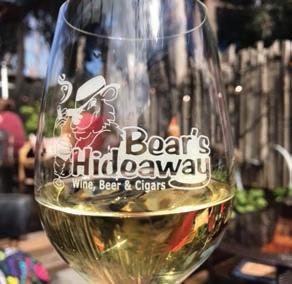











Salsa macha is the perfect accompaniment for seafood. It provides texture as well as a smoky note. Try making this simple tostada with cooked shrimp or for a vegan version use hearts of palm.
3 tablespoons salsa macha
3 tablespoons mayonnaise
1 ripe Hass avocado
1 lime
2 tablespoons soy sauce
4 corn tostadas
½ pound raw salmon or ahi tuna, thinly sliced
1 radish, thinly sliced
4 tablespoons cilantro leaves, shredded
3 tablespoons cooked yellow corn
Salsa macha and lime wedges, to serve
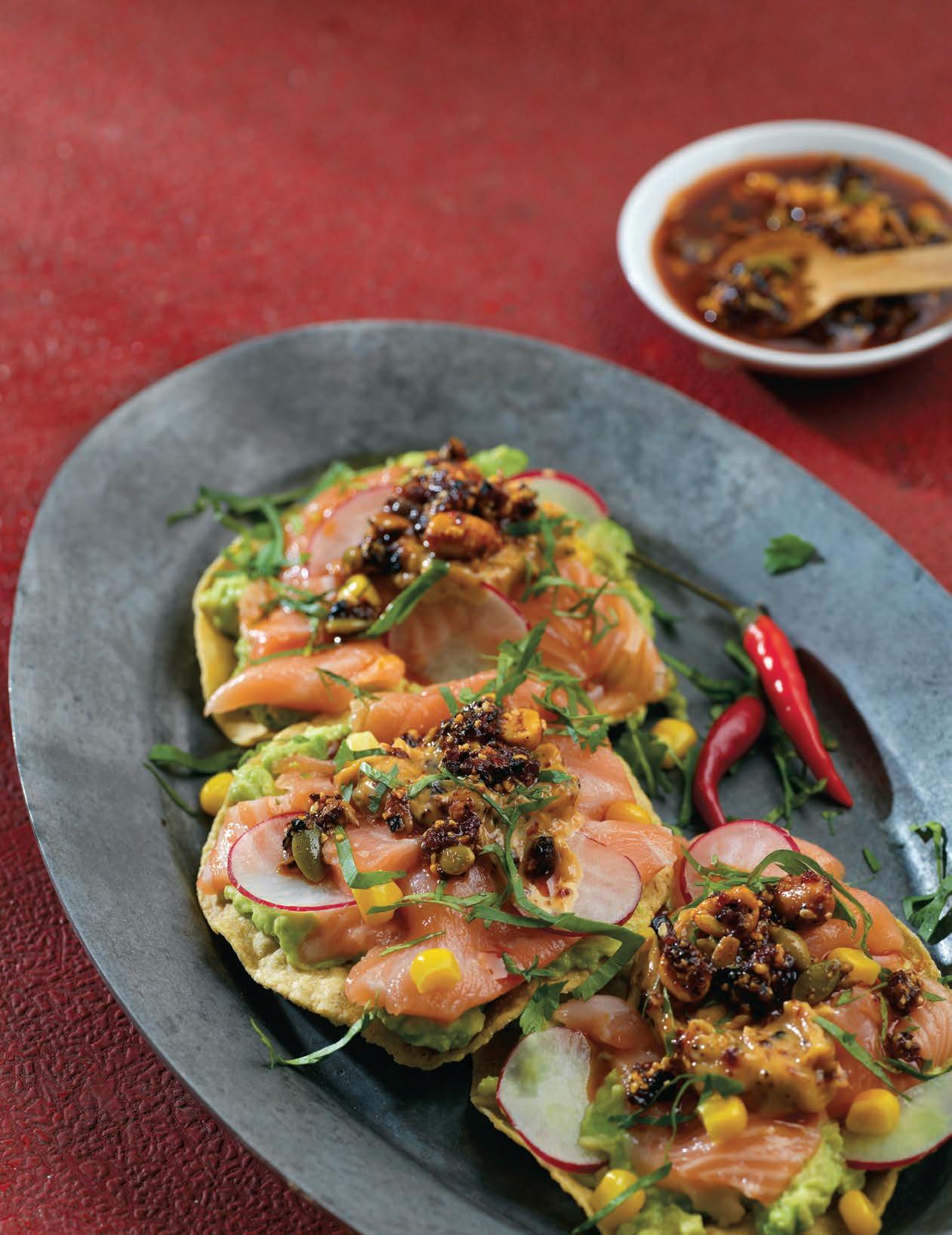
Combine salsa macha with mayonnaise and reserve.
Using a fork, mash avocado, season with lime juice and soy sauce.
Spread avocado on tostadas, add salmon, slices of radish and corn. Sprinkle with cilantro.
Top with salsa macha mayonnaise and additional salsa if desired. Serve with lime wedges. Serves 2.
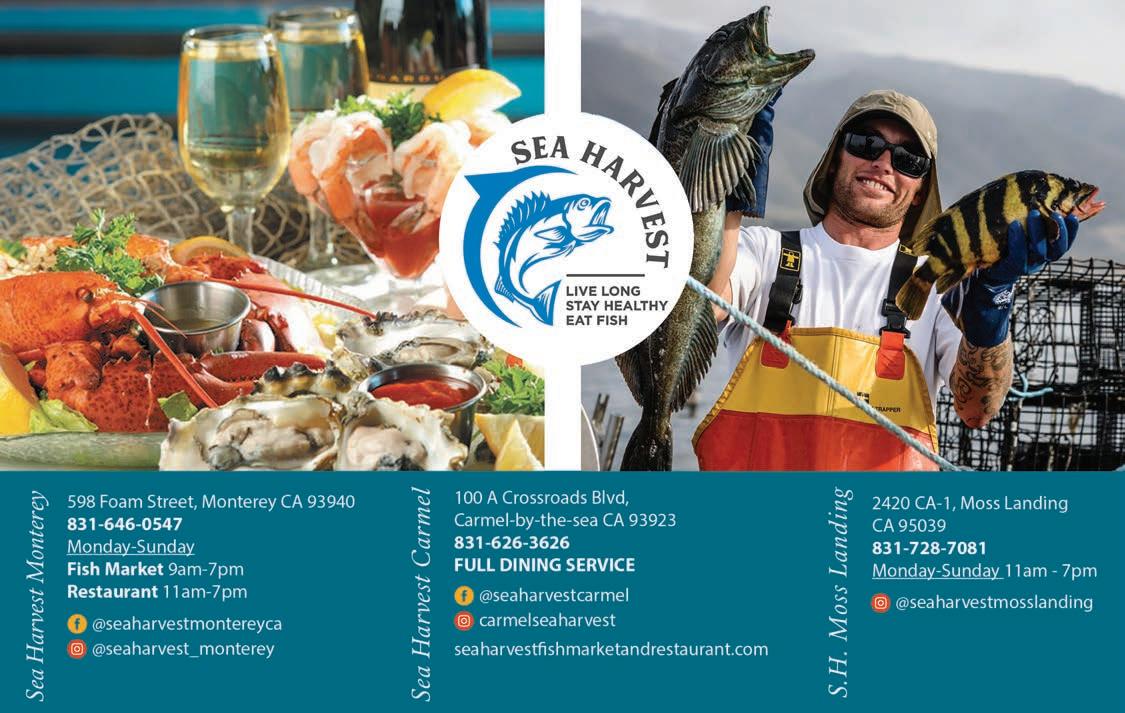

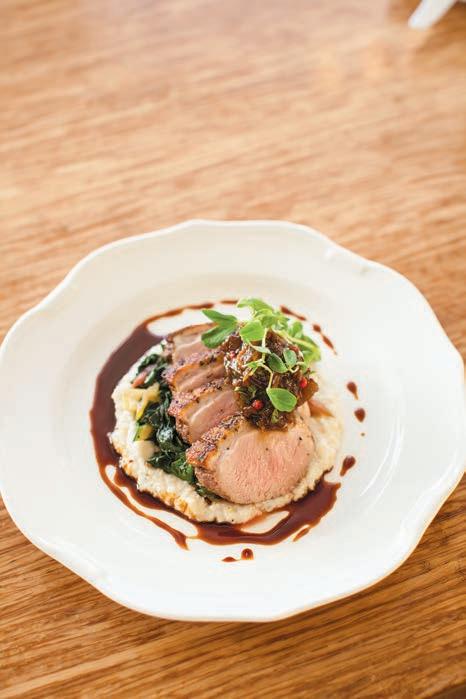 SPOTTED DUCK
RESTAURANT
SPOTTED DUCK
RESTAURANT

The other “other white meat” is a highly nutritious, sustainable protein, so why aren’t we eating more of it?
BY LAUREL MILLER PHOTOGRAPHY BY MICHAEL TROUTMANFor most Americans, rabbits are synonymous with childhood. We wear clothes adorned with fuzzy bunnies, while children’s literature and cartoons are rife with anthropomorphized characters like Thumper, The Velveteen Rabbit and Bugs Bunny.
“Unlike much of Europe, America is a chicken-eating nation partly due to the ease of butchering,” says Rob James, who raises meat rabbits at Pescadero’s Corvus Farm. “The desirable breast meat is easy to obtain, but you can’t discount the fact that we took what was once a food staple and made it a very popular pet, as well.”
Despite its widespread consumption in much of the world (according to British industry journal, New Foods, China and North Korea consume the most rabbit meat, worldwide), rabbit hasn’t been widely consumed in the United States since the mid-20th century. By contrast, the ancient Romans began breeding rabbits for meat and fiber— a practice known as cuniculture—in the 2nd century B.C.
Rabbit wasn’t always a controversial protein in this country. Wild rabbit and hare were consumed by Native American tribes, and then the first colonists brought European rabbits to America and bred the animals for meat. By the turn of the 20th century, rabbits were commonplace on homesteads. The meat didn’t fall out of favor until the 1960s, when beef and other livestock production increased.
Today, many Americans are aghast at the idea of eating rabbit because the animals are now typically viewed as pets, although there are also other factors (see “Snuggle Bunnies,” page 54).
Yet, of the 300 domestic rabbit
breeds worldwide, many are used for meat, including the New Zealand, Californian and Flemish giant.
It’s a shame that rabbit meat triggers so many people, because it’s lean, delicious, healthy and a highly sustainable protein source. Unlike hare, which is gamey and darker in color, rabbit is a delicate white meat with the highest percentage of protein per pound of any domesticated livestock or poultry animal. It’s also high in omega-3 fatty acids, vitamins and minerals like potassium, phosphorus and magnesium.
Compared to other livestock, rabbits also have a smaller carbon footprint. They require less food, water and space, and reproduce rapidly year-round. Their manure is also coveted, because it’s higher in nutrients and can be applied directly to plants without burning them. Despite their attributes, however, rabbits aren’t conducive to commercial production. They have fragile immune systems and are very sensitive to heat and environmental conditions. Even under ideal conditions, many rabbits make poor mothers, and can refuse to nurse or even cannibalize their young if stressed.
“I recall an old-time breeder telling me, ‘Rabbits are one of the hardest things to do right, and one of the easiest to do wrong,’” says James, who started raising the animals while living on a rural property in Los Gatos. “But they were and are a homestead staple because they’re so sustainable. A single adult rabbit will produce in its lifetime nearly an equal amount of meat as a cow, but with just a few square feet of space and a fraction of the water.”
James notes that the majority of rabbit consumed in the U.S. is sourced from Amish farms in the Midwest, or Canada. “If you’re buying local rabbit—or any meat—you have the opportunity to actually ask the farmer how it was raised.”


Humans are hardwired to find infants and animals with juvenile features (a large, round head and eyes, small nose, plump body) appealing. Austrian ethologist and Nobel Prize winner Konrad Lorenz introduced the concept of kindchenschema (baby schema) in the early 1940s. The National Library of Medicine defines this as “a set of infantile physical features…that is perceived as cute and motivates caretaking behavior in other individuals, with the evolutionary function of enhancing offspring survival.”
Rabbits, like many other species or animal breeds—think baby sloths or pugs—retain these juvenile characteristics into adulthood, a trait known as neoteny. So, the next time you balk at eating an atypical protein, you just might be triggered by an innate—and primeval—emotional response.

Corvus Farm sells mainly to high-end restaurants, but also operates a monthly meat CSA with pick up locations in Santa Cruz, Pescadero, Half Moon Bay and San Francisco.
James, a former Navy journalist and English teacher, initially began raising rabbits for his own consumption, but soon began receiving requests for meat from chef friends. In 2020, he had the opportunity to become a tenant farmer on a 30-acre parcel that was formerly part of a Brussels sprout farm at Año Nuevo. “I feel more fulfilled and like I’m making a difference as a farmer,” says James. “I also want people to be more conscientious about their meat. A $5 Costco rotisserie chicken is neither humane, nor sustainable.”
When James first took possession of his plot, the soil was depleted of nutrients, the result of 70 years of monocropping. Today, the land is recovering under a regenerative plan that includes rabbits, game birds, pigs and sheep. “Corvus is a real gem of a farm. Rob and his business partner Peggy (Switzer) really care about what they’re growing,” says Saison executive chef Richard Lee. “They don’t take shortcuts.”
Corvus produces Champagne d’Argent and other heritage breeds, as well as suitable crosses. They are fed an alfalfa-based pellet augmented with hay and pasture grasses.
The animals are housed in elevated hutches (“It’s almost impossible to raise rabbits any other way,” says James) to protect them from predators and diseases like tularemia and Pasteurella. Each enclosure is three-by-three feet, which allows the animals to stand on their hind legs; they’re also given time outside to play, forage and engage in other natural behaviors.
Most of James’ wholesale accounts are Michelin-starred restaurants like San Francisco’s Saison and Quince, and Carmel’s Aubergine and Chez Noir. Chez Noir chef/coowner and 2024 James Beard nominee Jonny Black has been using Corvus Farm products since the restaurant opened in late 2022.
“We strive to have a restaurant with a real sense of place and provide an experience that can only exist here,” says Black. “But I also feel that sourcing from local farms is the right way to cook. We got to know Rob while researching farmers, and I took my staff to Corvus. Nice guy, great operation, so we use as
much from him as possible. He’s right here; as a chef, why would I not buy from him?”
At Chez Noir, rabbit appears in various iterations on the constantly changing prix fixe menu. Black says he’s particularly fond of marinating the meat in buttermilk and deep frying it or pan-roasting the saddle (the main body, minus the head and legs). Another presentation calls for making a forcemeat of the legs, shoulders and liver, and stuffing the deboned, pancetta-wrapped saddle with the mixture. “It’s a rabbit hot dog type of situation,” says Black. “Rabbit is so tender and flavorful, people are surprised how good it is once they try it. Any chicken recipe will translate beautifully.”
At Jack O’Neill Restaurant, executive chef Gus Trejo maintains the same philosophy as Chez Noir. “We’re a community agriculture-based establishment,” he says. “Our menu is based on what’s available and in season here. When I first put rabbit on the menu, it was a tough sell, but I have an obligation to honor Rob and the animal, and all the work that went into raising it. I can cook anything, but if my staff isn’t educated or they don’t care, we can’t sell it. Now, people come back for rabbit specials.”
Growing up, Trejo spent summers with family in Portugal. His grandmother would cook ingredients sourced from her small town, or whatever his uncles—avid hunters and fishermen—procured. “It seems like rabbit was always available, because we’d catch them eating the cabbage in her garden,” he says.
Those experiences informed Trejo’s ethos as a chef. “When I started at Dream Inn in 2020, my goal was to work collaboratively with local farmers. I didn’t want it to be transactional,” he says. To facilitate such relationships, Trejo celebrates local proteins like Corvus Farm rabbit with speciesspecific Game Dinners, determining the preparation based upon what his farmers bring him. “None of our menu specials are premeditated,” he says. “Rob’s rabbit is amazing, so there’s no need to cover it up with thick sauces. We keep it simple because we can.”

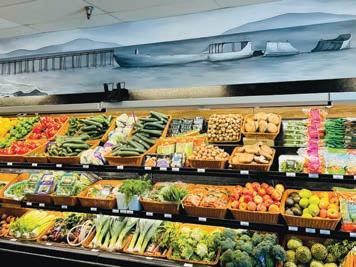
Rabbit is classified as poultry by the USDA, and like chicken, marketed by its age and weight. Fryers are eight to 10 weeks of age and yield three pounds of meat, while roasters are between 12 to 16 weeks and yield five to seven pounds. Stewers are animals over six months of age weighing more than seven pounds, ideal for low and slow methods like braising.
James’ wholesale rabbits are processed at Rabbit Barn in Turlock. If you’d like to purchase the meat for home use, Corvus Farm offers a private membership option for sales direct to consumer. For more information, visit corvusfarm.com.
Like Trejo, Soerke Peters, chef/owner of Pacific Grove’s Mezzaluna Pasteria & Mozzarella Bar, grew up eating rabbit. In his native Germany, his family raised the animals for meat. “I can remember my grandfather saying, ‘Let’s go get lunch,’ and he’d bring back a rabbit for my grandmother to cook. We usually had it braised with root vegetables and mashed potatoes, or deep fried.”
Peters sources his rabbits from a small farm in San Juan Bautista and typically features it in a seasonally changing pasta, like a spring saffron mafaldine with mushrooms, English peas and fava beans.
At Saison, Lee focuses on utilizing every part of the animal, curing and hot smoking the belly, braising the front legs, and cooking the loin and hind legs in the hearth, while the bones and trim are used for sauces. He recommends purging organs like the heart and kidneys in ice water or milk overnight, before sautéing them and serving them with a mushroom cream sauce augmented with a bit of Madeira or sherry to balance any funky flavors. The milder liver is excellent when pan fried or used in pâté.

Rabbit isn’t a forgiving meat, adds James, but the flavor is universal no matter the cut. “Think of rabbit as a three-pound chicken breast,” he says. “The texture and cooking method will differ, however, depending upon the cut. I love the forelegs the most, because you get these concentrated morsels of meat that force you to slow down and enjoy your meal.”
While cultural factors may prevent rabbit from regaining its former popularity in the U.S., Corvus Farm is the very definition of a small, diversified, regenerative agricultural operation, and James a staunch advocate of sustainable, if esoteric, livestock and poultry production.

In general, chef Lee suggests cooking the loin (the saddle is comprised of a loin strip on either side of the spine) and hind legs to a medium temperature to avoid drying them out. For the belly and front legs, treat them like dark meat by braising or confiting. “These cuts need more heat to break down the connective tissue,” he says.
“Rabbit is a difficult market,” he says. “I need partners like these chefs to collaborate with me, and I trust them to do right by all of my products. It doesn’t matter if they’re featured at a 3-star restaurant or a diner, I’m proud to have it on the menu.”
Laurel Miller is a food, spirits and travel writer, the associate editor of Edible Monterey Bay, and the former editor of Edible Aspen. She grew up on a California ranch where she raised rabbits and dairy goats; she has been writing about regenerative agriculture for over 20 years. When she’s not tethered to her laptop, Miller enjoys farmers markets and any trip that requires a passport. She’ll take a Mission burrito over a Michelin star, any day.
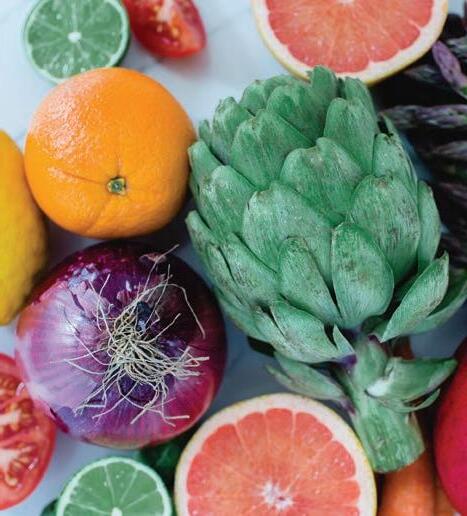
10% of profits go back to the community

Taste the flavors of Spring! We partner with local farmers to bring you high-quality organic fruits and vegetables, including favorites like asparagus and artichokes.
Swing into spring
Half Moon Bay • Downtown Santa Cruz Westside Santa Cruz








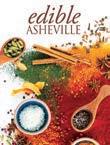



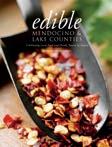
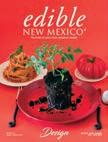
















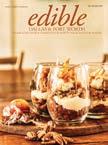













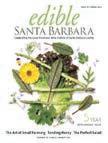









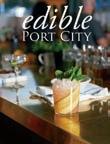






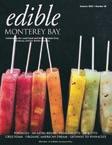




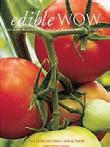







Entering Roxa Hammock Cafe is like walking into another world. The lighting, dim and purple hued, softly illuminates dark walls laden with ethereal decorations. True to its name, hammock chairs hang from the ceiling, offering alternative seating amidst sofas and chairs.
Though this scene in downtown Santa Cruz is transfixing, most people come to Roxa (pronounced “roe-sha”) for its herbal teas. In-

spired by the ancient practice of alchemy, Roxa serves a variety of non-alcoholic drinks that use different combinations of herbs to create a physical or mental effect.
“Tea brings people together,” says Michael Trainer, who opened the cafe in 2019 with partner Jazmin Grant. “There are so many things you can create with herbs, different concoctions and different feelings…enhance your libido, help you sleep, or as a social lubricant that isn’t alcohol and won’t give you a hangover.”
The Roxa menu looks like an old periodic table bursting with intriguingly named drinks like Truth Serum, Lucid Dreaming Tonic and Elixir of Immortality—beverages named for their intended effects. Each drink is chock-full of medicinal herbs, some well-known like reishi mushroom powder and spirulina, and others less common like betel nut, blue lotus and even powdered deer antler.
Menu items range from chilled tonics to hot beverages, some with espresso, as well as smoothies and acai bowls for more sustenance. Drinks come in various sizes and shapes, with each beverage served in an elaborate glass or mug matched to its distinct profile. To maximize health benefits, everything is vegan and free of refined sugar.
“Transformation plays a huge role in alchemy, so our drinks are very theatrical. There’s color changing drinks and steaming drinks, drinks that look like they should be in a laboratory,” says Grant.
The Artistic Vessel, for example, is served in rustic mugs and contains the herb rue, which is used to stimulate creativity and was consumed by Leonardo da Vinci and Michelangelo to enhance their artistic endeavors. The Wanderlust drink is served in a beaker-like glass and contains fermented African herbs that give an intoxicated feeling without alcohol.
Jazmin Grant became interested in herbalism after suffering a serious illness that doctors could not treat.
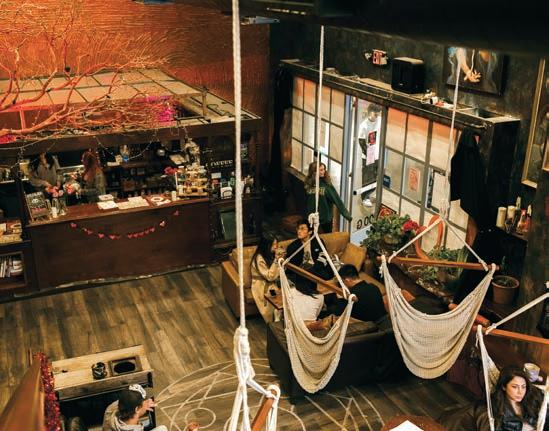

Between the one-of-a-kind menu, intricate aesthetic and hammock seating, it’s clear that Grant and Trainer put a lot of joy and passion into the cafe. But the initial inspiration sprang from a very hard time in Grant’s life. In 2016, she experienced black mold poisoning that eventually entered her brain and gave her a mild form of schizophrenia. When doctors failed to help, Grant took matters into her own hands.
“When the disease got so bad that I was bedridden, I had to figure out a way to heal myself…so I moved into a tent in my backyard to get away from the mold and I started studying herbs religiously,” said Grant. “I cured myself just from herbs, and I’ve been obsessed ever since.”
Once Grant experienced the powers of herbs, she dedicated herself to learning everything she could—from histories and medicinal
Whether you need a boost of energy or a dose of calm, Roxa has an elixir for it.
Hungover? Try the Hangover Remedy: Addresses hangovers via hydration and clearing free radicals with the C60 carbon molecule
Caught a chill? Try the Dandelion Cappuccino: Caffeine free, chocolatey taste, loaded with warming herbs that support gut health
Need a pick-me-up? Try the Mud Coffee: Coffee substitute with low caffeine and naturally stimulating herbs like betel nut (which truckdrivers chew to keep awake on long drives) and kola nut (in the original Coca-Cola recipe)

Sore muscles? Try the Filter of Regeneration: Contains powdered deer antler, which is one of the most powerful substances for regenerating muscle and bone tissue
Imbalanced gut microbiome? Try the Mercury Oil: A shot loaded with 102 herbs picked from the demilitarized zone between North and South Korea and black fermented for seven years
Feeling shy? Try the Truth Serum: Causes a giddy and talkative effect, contains pine pollen which is so nutrient dense that it has a mood-altering effect
Immune support? Try the Lodge Tea: A drink that came to Grant in a dream, it contains a blend of stinging nettle, osha root and pine needles, used in Native American sweat lodge ceremonies for lung support and overall health
properties to traditional uses and new applications. She even dreamed of someday opening a teahouse to share the transformational properties of herbal alchemy with the community.
Grant met Trainer while working at the Japanese-style bathhouse Kiva Retreat the following year. They became fast friends, bonding over their shared love for event promotion and going on to organize events at the retreat space, like hot tub movie nights. Over time, their relationship grew into a romantic connection that would lead them to open Roxa and take over the Kiva lease, reopening it as Maitreya in 2020.
“I fell in love with her and with all the things she loved, including herbs,” says Trainer. “Jaz already had a dream of creating a metaphysical teahouse, and I wanted to share that with her. And Santa Cruz is perfect.”
Santa Cruz has proved to be the perfect place for Roxa. The cafe operates as a daytime teahouse, stays open as a late-night lounge and also hosts special events. From
the beginning, a big part of Grant and Trainer’s vision was to build a community space to share the transformative powers of herbs while also curating eclectic events ranging from dance parties to chamber music concerts, and some very creative ideas in between—like a murder mystery event in the works for April.
“My favorite events we’ve hosted are the speed dating and tarot night,” says Grant, who noted speed dating events usually occur in the beginning of the year and tarot in the fall. “For the tarot night, we fill the whole room with local divinators—tarot readers, palm readers, tea leaf readers, Mayan astrology readers, face readers, anything like that—and it’s all donation based. So you can get 12 readings in one day.”
Ashley Drew Owen is a writer and Massachusetts transplant. Her passion for learning about local food is only overshadowed by her passion for writing about or eating it. Safe to say, she is a lover of food and words, and also driving very fast in the left lane.







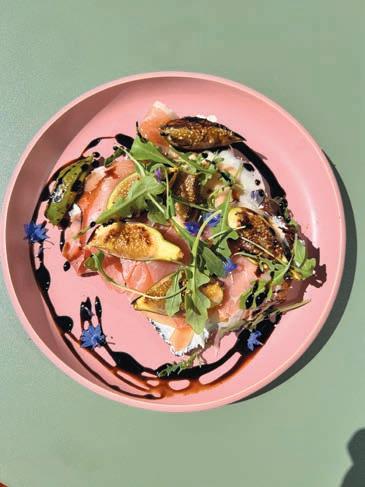
7 vegetables to plant now and enjoy for years to come
BY JILLIAN STEINBERGER-FOSTERPerennial vegetables are like old friends. You nurture them over the years, strengthening your bond, learning to know them on a deeper level. Compared to annuals, which come and go in a season, perennials usually die back in winter and come alive again in spring, although some produce year-round in our area.
Since they are already established, you don’t need to start from scratch with new starter plants or seeds. They take less work and offer a good yield. Enjoy both new and familiar flavors with the following perennial vegetables.
Cynara cardunculus
Two-thirds of the world’s artichokes are grown in Monterey County, and the town of Castroville is known as the “Artichoke Capital of the World.” The rich soil of the Salinas Valley combines with the sandy soil of Monterey Bay, providing the fast-draining soil that the artichoke desires. So growing them in your garden should be a slam-dunk.
The artichoke, considered a superfood, has been eaten for eons for its health benefits. It is low calorie, low carb and high fiber. It is even sold as a supplement or extract, recommended for digestion (including irritable bowel syndrome), and liver and heart health.
It’s also an impressive landscape plant, with large, exotic-looking purple flowers set off by long, arching grey-green foliage. In the ground artichokes can grow up to 6 feet high and 8 feet wide. They also do well in raised beds, but will stay about 4 feet tall. They toss up new little plants that grow into tall flower stalks. Let them spread and multiply, if you have the room.
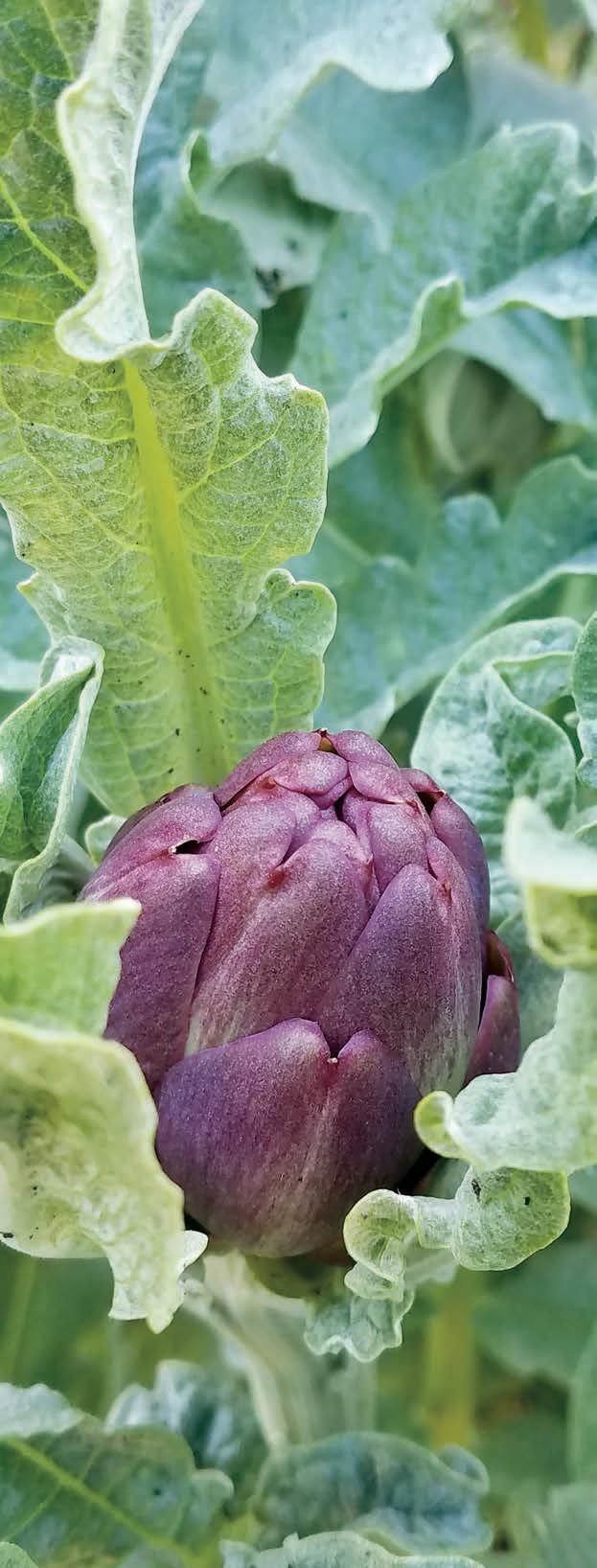

Plant in at least two feet of good rich soil. Water moderately but regularly. The plants will look brighter and produce more flower heads (the part we eat) if they are fertilized once a month with an organic, balanced, granular fertilizer like E.B. Stone All-Purpose Plant Food, and I also throw a bucket of organic fish/kelp emulsion on the colony. When harvesting, cut back to a node; the branch may regenerate and bear more heads. When stalks get thick and woody, cut them to the ground. I also remove yellowing, spent or buggy leaves, to allow in light and air, which encourages the plant to regenerate and continue to provide thistles for a long, long time.
ASPARAGUS
Asparagus officinalis
Asparagus grows well along the Central Coast. It likes sandy soil—so it is perfect for some mountain gardens. It can even take some salt in the soil and may be suitable for beachside gardens.
“Asparagus is a great crop because it can thrive in areas of your garden that other crops might not,” says Reed Dahlmeier, a high-energy homesteader with a 4-acre, organic farm in Aptos.
“Perhaps I’m biased, but I swear they are substantially sweeter and more succulent when grown at home and eaten fresh. Giving our asparagus a healthy pile of compost once or twice a year has led to our largest, sweetest spears. My favorite way to cook them is to sear them in a little olive oil or toasted sesame oil, then just as they get tender, add a huge pile of minced garlic and a big pinch of salt.”


Asparagus can be weedy, so plant in a raised bed unless you have a large garden where it can ramble. Grow in full sun, in rich, well-drained soil. Harvest asparagus from March to June. As Dahlmeier notes, a thick layer of compost is key. Asparagus takes patience, and you must wait a couple years before harvesting. However, your patch can live for up to 15 years.
RHUBARB
Rheum rhabarbarum
Rhubarb is famously used in strawberry rhubarb jam or pie, and those who love it can’t get enough of the sweet-tart edge it imparts. I am one of them. It’s hard to turn down a piece of strawberry-rhubarb pie, diet or no diet. Anyway, rhubarb can persist in the garden with neglect, even in full sun and almost no water. It will look like hell, but it probably won’t die! That said, if you want to get a good harvest, it needs a little loving care to produce—weekly watering and occasional fertilizing with fish emulsion won’t hurt. Harvest the stalks when they turn red. Do not eat the leaves, which are poisonous.
This plant has tough roots. Herbalists value the impressive thick whitish root as a demulcent for constipation. (So, if possible, offer your big stalk to an herbalist, if you happen to pull the roots out, instead of putting it in the green bin.)
If it dies back—which it may not in our mild winter climate, especially if it is in a sheltered place—it will come back hardy and strong the next year. Rhubarb likes full sun but can take some shade. Give it at least three feet of space to spread its stalks or it will smother the plants around it. Note that when it flowers, it is bolting. Cut the flowers back if you dare—the flower is curiously strange and beautiful. Although bolting won’t hurt the flavor, cutting it back will result in a bigger harvest. They say a rhubarb patch can last over 100 years!
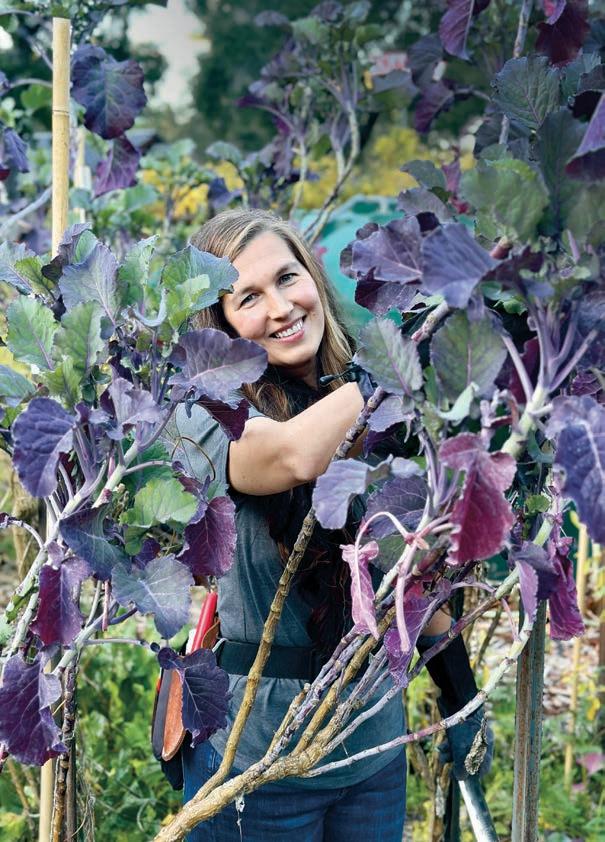
Brassica oleracea var. viridis
Just about all year round, when you need some greens and nothing else in your garden is producing—and you don’t want to go to the store—tree collards may be your saving grace. The succulent dark green leaves—easy roughage—goes well any way you would use kale, like sautéed, in scrambled eggs or a frittata or as part of a casserole or soup. You can also use the big leaves as a wrap for raw sushi or burritos. And, if you juice, tree collards are a dream plant—a near constant source of dark leafy greens to give you that electric jolt in a Mason jar.
“Perennial tree collards are one of the most generous plants you can grow in the garden,” says holistic chiropractor and permaculture homesteader Christy Garner. “They give so much and ask for so little. In my garden, they produce year-round.”
Garner, who has an expansive homestead in Felton, develops and selects seeds for the tastiest, tallest, most robust and beautiful plants. Her varieties vary between 6 and 10 feet tall. She sells four named varieties that have different growth habits, different shades of light green to purplish leaves and unique if similar flavors, on her website plantonce.com.
Tree collards can grow in a container, but will get larger and stronger in the ground. Plant in full sun to part shade and water weekly. Fertilize lightly with organic fish/kelp emulsion.
Sechium edule
Chayote is a plant for the people. It can feed an army. A vine can grow 30-feet long and produce 50 or more squash fruits from October to January on the Central Coast. It is versatile in the kitchen and tastes something like zucchini…or maybe winter squash. Yet it’s a little crunchy and hydrating, like a cucumber. Indeed, chayote is in the cucurbit family as are zucchini, squash and cukes. And it is also reminiscent of potatoes. It is familiar—and yet not.
A healthy food, it is low glycemic, low calorie, low fat and high fiber. Like nopales (cactus pads), it can help reduce the risk of diabetes and heart disease. Chayote is grown all over the world, but comes to us from Mexico and Central America, where it is a well-loved staple.
“We have eaten them raw, stir fried, steamed and in soups,” says Dahlmeier. “I first came across chayotes in a Oaxacan beef soup recipe that my family and I love, but found the fruit hard to come by in most markets.”
So, he started growing them. They are easy—regular water and compost will do. To grow chayote, he advises, first find one at a grocery store. “You can place the fruit in your windowsill until it sprouts. Then just plant the fruit halfway in the soil with the sprout above the soil.”
Plant it in a sheltered area in full to part sun, next to a trellis, a fence or a tree so it can climb and not get stepped on. The next thing you know it will be shooting up above your head, and you’ll be looking up at squashes. Dahlmeier’s family also makes chayote bread with chocolate chips—similar to zucchini bread.

Solanum betaceum
Tree tomatoes have migrated our way from Central and South America. Also called tamarillos, they are not tomatoes, but they resemble them and are reminiscent of them. The skin feels similar. You would choose the same knife to slice them. When you cut them in half, they have beautiful vibrant flesh that is the same consistency as tomatoes, with their seeds similarly displayed. They come in the same colors as tomatoes—a range of reds, oranges and yellows.
Yet they taste different. The flavor is nuanced—somehow mysterious—often described as tart, sweet and tangy.
This attractive landscape plant has large tropical looking leaves, edged in purple. The pretty whitish flowers turn into beautiful, jewellike hanging fruit. The Central Coast is a perfect place to grow them— they like our mild weather. Tree tomatoes like a sunny but sheltered spot. They grow to around 6 feet tall by 4 feet wide, with weekly water and occasional fertilizer.
Santa Cruz Fruit Growers, a volunteer organization with a fruit jungle at Whiskey Hill Farms in Watsonville, has grown 60 varieties of tree tomatoes in greenhouses there—for fun, and potentially for profit, if they can develop a market for them. Maybe they will, as this is a taste of home for my friends from Guatemala, who literally tear up when they see a tree tomato growing here.
Slawek Wojtowicz of Prunedale, an active member of the group, is an expert on tree tomatoes and other unusual fruits. He wrote “the book” on tree tomatoes, eponymously titled Tamarillos aka Tree Tomatoes.
Explaining their appeal, he says, “Being less common in some parts of the world, they add an exotic touch to dishes and are sought after by culinary enthusiasts looking to try something different.”
In our native foodways garden, my dear friend Emiliano Sanchez bites into tamarillos raw, like garden snacks. Sanchez showed me how

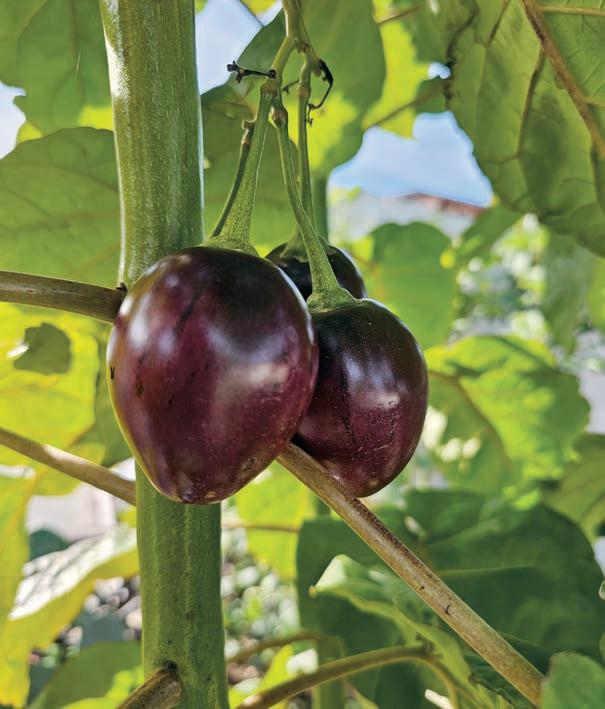
his family eats them with eggs in the highlands of Guatemala. They boil them, remove the skin and seeds, mash them and whip them into raw eggs before scrambling or making an omelet. The result is delectable umami-flavored eggs. I also mashed one up and put it in a soup with meaty runner beans, garlic, a sweet red pepper, garden cilantro and Himalayan salt. The taste was magical. The rich broth edged on smokiness. Spices would have been superfluous.


Phaseolus coccineus
With their graceful red flowers, scarlet runner beans are perhaps the most beautiful beans a gardener can grow. Although the pods look leathery, they are yummy green beans in late spring to mid-summer. By late June you can harvest them as fresh snap beans. You can also let them mature into 8-inch-long pods and leave them to dry on the vine. Just be sure to pick them before the rains, so they don’t rot.
Scarlet runner beans are a chef’s favorite. This satiating bean is large and meaty, with a creamy consistency, and holds its shape through cooking. It makes a delicious broth, and is perfect for a hearty soup or chili. Served fresh, the beans will pretty up a salad. (The young beans may be violet.) And so will the flowers, which are edible. The dry beans are shiny and speckled purple and black. However, if you want to eat these beans, you will probably have to grow the plants yourself, as they are rarely available at stores or farmers markets.
Hummingbirds love the plants, hovering over them and drinking nectar. In fact, local seed producer, Renee’s Garden, includes a scarlet runner bean variety called magic beanstalk in its Hummingbird Garden packets. It also sells painted lady, with red and white flowers, and hestia dwarf for containers. Rare Seeds sells the varieties black knight, black coat and sunset. Occasionally you can find them at local nurseries as 4-inch starts, as these beans are getting more popular.
Scarlet runner beans are easy to grow, and prolific. They like full sun, regular water and well-draining soils. Like other pole beans they need supports to climb on, and can grow to 12 feet tall.
Jillian Steinberger-Foster is a regenerative landscape gardener and designer. She is co-owner of Terra Nova Ecological Landscaping with her husband, contractor Ken Foster. They have a thriving homestead on the Westside of Santa Cruz and three active rescue dogs.
Christy Garner shares a wealth of growing tips and sells offthe-beaten-path seeds and plant starts on her website, where you can also read her book Perma Veggies: Plant Once, Eat Forever. plantonce.com
Reed Dahlmeier is an active community gardener and member of the Monterey Bay Chapter of California Rare Fruit Growers. He propagates and grows many hard-to find plants. Visit him on Instagram @littlebootsandroots or email littlebootsandroots@gmail.com to be added to his mailing list.
Slawek Wojtowicz is the author of the book Tamarillos aka Tree Tomatoes and one of the mad scientists behind the vast fruit jungle at Whiskey Hill Farms in Watsonville. Learn more at santacruzfruitgrowers.com.
















































FROM FIELD, TO MARKET, TO TABLE… OUR PRODUCE IS ALWAYS FRESH, ALWAYS LOCAL



FOR OVER 80 YEARS, SHOPPER’S CORNER HAS BEEN PROUDLY SERVING THE SANTA CRUZ COMMUNITY.
We delight ourselves in bringing you the highest quality meats, produce, wines and specialty items, many of which come from local vendors right in our own backyard. Over the years we have found that by using the best available ingredients, you get the best possible meals! So when looking to prepare that perfect feast, know that we are here and happy to help. From our family to yours....Thank you for making Shopper’s Corner a cherished part of the Santa Cruz community.


All of these restaurants emphasize local ingredients and they also advertise in Edible Monterey Bay! So please check online before you go and tell them we sent you.

Persephone
7945 Soquel Drive 831.612.6511 • persephonerestaurant.com
With a namesake like the mythic Persephone, this restaurant in Aptos proclaims its deep reverence for seasonal cooking. Themes central to harvest, winter and spring are core to Persephone’s story, and are reflected in the changing menu at this fine dining destination, where chef Cori Goudge-Ayer presents inventive, ingredient-driven creations. The restaurant is a family-run passion project, bringing together parents, siblings and a long history of culinary arts in a beautifully redesigned space overlooking Aptos Creek. Open for dinner W–Sa 5–8:30pm. Fourth Sundays, Winemaker Dinner with five-course pairing menu.

Capitola Wine Bar and Merchants
115 San Jose Avenue
831.476.2282 • capitolawinebar.com
Where the wines meet the waves, Capitola Wine Bar can be found in the seaside village of Capitola and offers small batch wines hand selected by its team of certified sommeliers. Wines from all over the world are available, by the glass, bottle or flight, along with local beers and a great kitchen. Events are always happening like Live Music, Paint Nights, Trivia Nights, Wine Blending and more. Don't miss the dog-friendly patio and the $7 happy hour Tu–F 5–7pm. Open Tu–Th 3–9pm and F–Sa noon-10pm.
New Leaf Community Markets
161 Aptos Village Way 831.685.8500 • newleaf.com


This latest branch of the beloved local market group occupies the remodeled Hihn Apple Barn, built in 1891. In addition to local groceries and organic produce, New Leaf Aptos has made-to-order sandwiches, pizza, freshly rolled sushi, soup and hand-prepped salads, as well as a coffee bar, juice and smoothie bar and organic Straus soft serve ice cream. Open daily 8am–9pm.
The Penny Ice Creamery
141 Aptos Village Way, Suite 2 831.204.2523 • thepennyicecreamery.com
Open Su–Th noon–9pm, F–Sa noon–10pm. See The Penny description under Santa Cruz for more.
Seascape Foods
16B Seascape Village • 831.685.3134
A charming family-owned market with an ample deli counter featuring daily chef specials, salads, breakfast items, freshly squeezed juices and sandwiches on housemade organic sourdough bread. The grocery section includes organic produce, artisanal products, local beer and wine, and gifts. Eat outside next to the fountain on the patio or take your goodies to the beach nearby. Open daily 8am–8pm.


New Leaf Community Markets
1210 41st Avenue
831.479.7987 • newleaf.com
The café at the entrance offers great alternatives to fast food, serving economical daily specials, wraps, pizza and homemade soup and espresso drinks—with free wi-fi in the outdoor dining area. Inside the market, a full deli has made-toorder sandwiches, healthy takeout salads and entrée items. Open daily 8am–9pm.
The Penny Ice Creamery
820 41st Avenue
831.204.2523 • thepennyicecreamery.com
Open Su–Th noon–10pm, F–Sa noon–11pm. See The Penny description under Santa Cruz for more.
Trestles
316 Capitola Avenue
831.854.2728 • trestlesrestaurant.com
Just steps away from the iconic Capitola train trestle, chefowner Nick Sherman’s passion for great food is evident in every dish at his popular neighborhood bistro. Local seasonal ingredients star in appetizers like chicory salad, roasted fairytale pumpkin with goat cheese and mole negro, Brentwood street corn and crispy pork belly with watermelon radish. Entrées include smoked eggplant gnocchi, Niman Ranch pork chop and fresh fish—all served with local wines and craft beers on tap. Open W–F 5–9:30pm, Sa–Su 4:30–9:30pm.




Covey Grill
8205 Valley Greens Drive
831.620.8860 • quaillodge.com/dining/coveygrill
Covey Grill at Quail Lodge features USDA steaks and sustainably sourced seafood complimented by unique plantbased offerings in addition to seasonal American cuisine. Covey Grill offers casually elegant indoor and outdoor dining options against the stunning backdrop of Quail’s sparkling lake and lush garden landscapes. Open for full dinner service Mon–Sun 5–9pm, with bar opening at 4pm.
Earthbound Farm’s Farm Stand
7250 Carmel Valley Road
831.625.6219 • earthboundfarm.com
Earthbound Farm’s 100% certified organic kitchen delights with specialty coffee and tea, soft serve ice cream and a made to order breakfast and lunch menu—including soups, sandwiches, salads, baked goods, fresh juices and smoothies. Food is available to be enjoyed on the beautiful grounds or for takeaway. In addition to certified organic produce, the Farm Stand offers a selection of natural, organic, local beer and wine, groceries, gifts and flowers. Stroll through the gardens and learn about Earthbound’s commitment to organic integrity. Open daily, but check hours online as they change seasonally.

Grasing’s
6th Avenue and Mission
831.624.6562 • grasings.com
Chef-proprietor Kurt Grasing’s namesake restaurant has expanded since opening in 1998 to include two large dining rooms, multiple outdoor dining areas and the ever-popular bar/lounge. A Carmel classic located in the heart of the village, Grasing’s serves California cuisine, with an awardwinning wine list and a vintage spirits program featuring classic cocktails made with rare Mad Men-era gins, whiskeys, Camparis and amaros. Open daily M–F 11am–9pm, Sa–Su 10:30am–9pm.

Sea Harvest Fish Market & Restaurant
100 Crossroads Boulevard, Suite A 831.626.3626 • seaharvestfishmarketandrestaurant.com
The Deyerle family that owns this local gem has its own fishing boats for the freshest catch on the Monterey Peninsula. Sea Harvest doubles as a fish market and casual restaurant with indoor and outdoor seating. The oysters and clam chowder are customer favorites, but don’t miss the fried combo platter, grilled fillets and fish tacos. Open daily 8am–8pm.
Stationaery
San Carlos Square, Between 5th and 6th avenues 831.250.7183 • thestationaery.com
A neighborhood restaurant offering daily brunch and lunch, Stationaery is owned by your hospitable hosts Anthony and Alissa Carnazzo. The kitchen team, led by chef Amalia Scatena, specializes in comforting flavors and local ingredients, with elegant presentations. A new bottle shop next door offers a good selection of European and California wines to enjoy with your meal or take home. Brunch daily 8am–3pm. Dinner Th–Sa 5:30–9pm.

Jerome’s Carmel Valley Market
2 Chambers Lane
831.659.2472 • jeromescarmelvalleymarket.com
A chef-owned, friendly neighborhood market, Jerome’s offers local and organic produce, natural meats and seafood, and a great selection of domestic and imported wine, beer and microbrews. French-trained chef and owner Jerome Viel prepares delicious hot foods, sandwiches and salads for eating at outdoor seating or take-away. The offerings start with breakfast burritos, croissants and other French pastries in the morning, followed by favorites such as coq au vin, spaghetti carbonara and chicken enchiladas for lunch and dinner. Open M–Sa 7am–7pm, Su 7am–6pm.

Lucia Restaurant & Bar
Bernardus Lodge & Spa • 415 W. Carmel Valley Road 831.658.3400 • bernarduslodge.com

Indulge in artisanal California country cuisine, award-winning wines and an expansive heated outdoor terrace with the finest restaurant view in Carmel Valley. At this Forbes 4-Star charmer, named for the Santa Lucia mountain range and wine appellation that beckons to the south, executive chef Christian Ojeda offers both a signature tasting menu and dishes à la carte. Wine list is equally notable. A chef’s table and wine cellar are also available for private dining and special occasions. Open daily 7am–9pm. Live music Tu 4–7pm. Saturday and Sunday brunch with live music 11am–2:30pm.
Sunny Bakery Cafe
18 E. Carmel Valley Road
831.659.5052 • instagram.com/sunnybakerycafe
Friendly local café offering homemade pastries, espresso drinks and light fare. Warm, welcoming service and a great array of treats made daily on site with wholesome ingredients that honor the seasons. Owner Analuisa Bejar heads the locally-minded kitchen with favorites like egg sandwiches, quiches, panini, frittatas, and irresistible BLTs. Buttery pastries, cookies, cinnamon rolls, muffins and cakes round out the list. Open W–M 7am–1pm.

Davenport Roadhouse
1 Davenport Avenue 831.426.8801 • davenportroadhouse.com
The iconic Highway 1 waystation cultivates a range of reasons to linger longer, starting with a wide menu starring rib-sticking plates like giddyup garlic bread, wings, fried pickles, salads and wraps, pizzas, burgers, steaks and a fisherman’s stew. Extensive dog-friendly outdoor patio seating (and doggie dishes); midweek specials like Taco Tuesday, Trivia Wednesday and Thursty Thursday with tons of $5 deals; and live music Friday through Sunday too. Open M 11am–4pm, Tu–Th 11am–8pm, F 11am–9pm, Sa–Su 9:30am–9pm.

The Grove Cafe and Bakery 6249 Highway 9 831.704.7483 • thegrovefelton.com
Chef Jessica Yarr’s community-focused café serves breakfast and lunch dishes brimming with bright flavors and local, seasonal produce. A variety of breads—sourdough, mountain rye and Japanese milk bread—are made in-house and star in dishes like the mushroom magic toast with roasted shiitake and oyster mushrooms, and goat cheese, or the signature smoked beet Reuben sandwich. Breakfast bowls, hearty salads and 11th Hour Coffee drinks round out the menu. Open Tu–Th 8am–4pm, F–Sa 8am–6pm, and Sunday brunch 8am–3pm.
Wild Roots Market
6240 Highway 9 • 831.335.7322 (Felton)
13159 Highway 9 • 831.338.7211 (Boulder Creek)
wildrootsmarket.com
Wild Roots’ 100% organic produce, natural groceries, organic meats and FishWise-certified seafood all go into the prepared foods offered by the store’s full-service deli, salad and soup bar and juice bar. Enjoy on the patio out in front or take home. Open daily 9am–9pm.

La Catrina Mexican Grill
449 San Benito Street 831.313.0905 • catrinagrill.com
Family owned and operated since 2014, La Catrina offers classic Mexican tacos and enchiladas along with specialties, including chiles rellenos, cochinita pibil and garlic shrimp.



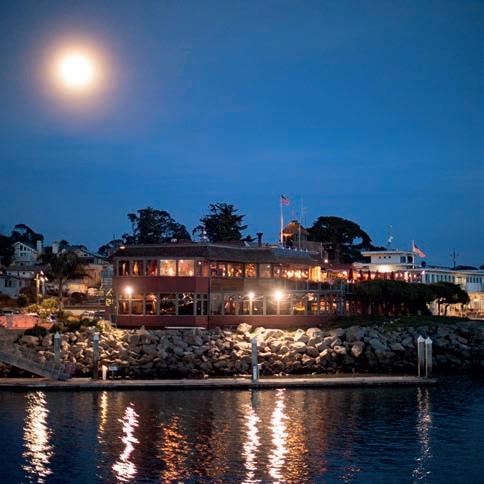

Drink specials are available nightly, and there’s outdoor patio seating. Don’t miss La Catrina’s weekend brunches with chilaquiles, omelets, pancakes and menudo. Open M–Th 11am–9pm, F 11am–10pm, Sa 9am–9:30pm, Su 9am–8pm.
Paine’s
421 East Street
831.637.3882 • paineshollister.com
Hollister’s favorite casual fine dining destination for nearly 100 years, Paine’s offers a wide selection of tasty pastas, fresh seafood, grilled steaks and chicken dishes. The peaceful atmosphere and white tablecloths make it a good place to slow down and relax with a glass of wine, or enjoy a beer while watching a game at the bar. Banquet facilities are also available for large groups and special events. Open M–F for lunch 11am–2:30pm and dinner 4:30–9pm, Sa for dinner only 4:30–9pm. Closed Su.





Running Rooster
800 San Benito Street
831.634.0135 • runningrooster.com
With a passion for providing high-quality, honest food and great service, Running Rooster is a lively place to stop in for lunch or dinner. Choose among eight varieties of burgers, tacos, meal-sized salads and wood-fired pizzas. Heartier fare in the evening also includes steak, oven roasted salmon, short ribs and rotisserie chicken. There’s brunch on weekends, and a full bar serves craft cocktails, local wines and 23 beers on tap. Open W 4–8pm, Th 11am–8pm, F 11am–9pm, Sa 10am–9pm, Su 10am–8pm. Closed M–Tu.
Ad Astra Bread Co.
479 Alvarado Street adastrabread.com
Come for the legendary all-organic sourdough—Seaside sourdough, olive sourdough or seeded sourdough—slowfermented in a two-day process. (Or the focaccia, or French baguette.) Stay for the big-city coffee and creative sweet treats, while enjoying the spirited and youthful service and watching the Ad Astra elves through the tall glass wall separating the cafe and production area. Open M–Su 7am–5pm.

Alta Bakery + Cafe
502 Munras Avenue 831.920.1018 • altamonterey.com
The line out the door amplifies anticipation for what lies inside. The coffee-tea program proves solid, but here the stars are the goodies from award-winning chefs Ben Spungin and Erika Neargarder. Prioritize the creative pastries, but keep some stomach space available for the nine-grain pancake, smoked-salmon toast and Bloomsdale spinach sandwich with Baker’s Bacon and green goddess dressing. Kombucha, beer and wine on tap too. Open daily 7am–4pm.

Cella
525 Polk Street 831.920.1046 • cellarestaurant.com

The owners of Alta Bakery took their time opening this local gem, because 1) Business was so brisk at the bakery, and 2) They wanted to get everything dialed in for the contemporary fresh California experience next door. Then Cella added chef Cal Stamenov, the quintessential “chef’s chef” of the Central Coast, who blends classic technique with local simplicity and the idea of slow food cooking. Highlights include the braised beef cheeks, diver scallops with trumpet mushrooms and herb-fried chicken. Alta breads and masterful cocktails complete a fly formula. Open Tu–Sa 5:30–9pm, Su 10am–2pm.
the C restaurant + bar
750 Cannery Row 831.375.4500 • thecrestaurant-monterey.com
Step into the C restaurant and the bustle of Cannery Row

will seem like a world away. Elegant yet relaxed, a stun ning renovation opens up ocean views through the C’s floor-to-ceiling windows and oceanside deck. Executive chef Matt Bolton provides equally gorgeous food imagi natively prepared from sustainably sourced seafood, meats and produce. Food Network baking contestant Michelle Lee is sous chef, and puts her creativity to work for unique desserts and other menu contributions. Creative craft cocktails are sure to please. Open daily for breakfast M–F 7–11am, Sa–Su 7–11:30am; for dinner Su–Th 5–9pm, F–Sa 5–10pm. The C bar opens at 4 pm daily, with Hap py Hour M–Th 4–6 pm.
Coastal Kitchen
400 Cannery Row
831.645.4064 • coastalkitchenmonterey.com
Executive chef Michael Rotondo’s tasting menu at Mon terey Plaza Hotel’s flagship restaurant represents one of the most habit-forming in the region, but there’s a lot more to recommend this spot. From a newly-refreshed dining room, sweeping views of the Pacific await from each seat. Local delicacies receive elevated treatments: tempura artichoke with black button sage honey, wood-roasted black cod with shishito, squash blossom and charred coconut jus, and king salmon with raspberry, aromatic herbs and seasonal tomatoes—paired with hand-picked top-shelf wines. It’s a place well worth the splurge. Open Tu–Sa 5:30–8:30pm.

Estéban Restaurant
700 Munras Avenue 831.375.0176 • estebanrestaurant.com
At the heart of the downtown Monterey dining scene, Estéban Restaurant serves Spanish influenced cuisine made from local, seasonal ingredients, which can be enjoyed on the Mediterranean garden patio that now includes a classic pergola with toasty heaters. The menu features a selection of long-time Estéban favorites, as well as new dishes created by executive chef Ben Hillan, like Vieiras con Jamón (seared scallops with Serrano ham) and Mejillones y Almejas (mussels and clams with chorizo and saffron/ achiote broth). Open for dinner Su–Th 4:30–8:30pm, F–Sa 4:30–9pm. Brunch Sa–Su 10am–2pm. Tapas hour from 4:30–6pm daily.

Jacks Monterey
2 Portola Plaza
831.649.7830 • jacksatportola.com
Jacks Monterey provides a refreshing culinary experience in downtown Monterey, inside the Portola Hotel & Spa. Emphasizing local ingredients, high-quality seafood, and an award-winning wine and cocktail program, Jacks philosophy derives from globally-inspired traditions of California Cultural Cuisine. The atmosphere at Jacks is sophisticated— never pretentious. Open daily for breakfast 6:30–10:30am, dinner 4–10pm, and bar only F-Sa 10–11pm.

Peter B’s Brewpub
2 Portola Plaza
831.649.2699 • peterbsbrewpub.com
Peter B’s Brewpub combines award-winning craft beer and sports on 18 high-definition televisions in a relaxed brewpub environment. Monterey’s original craft brewery is distinguished for its variety of beer on tap, innovative pub menu, happy hour, sports bar atmosphere, and outdoor dining on the pet-friendly heated patio with fire pits. Peter B’s is open Thursday-Monday with nightly happy hour from 4–6pm, as well as late night happy hour 9–10pm. Open Th-M 4–10pm. Sunday breakfast and football 9:30–11am from September to January. Closed Tuesday and Wednesdays.

Schooners Monterey
400 Cannery Row 831.372.2628 • schoonersmonterey.com
Residents regularly vote Schooners Best Drink With a View, and they’re not wrong. The eye candy rolls from the waves crashing on the tidal zone below to Seaside and Santa Cruz beyond, and the sippers are memorable. But that’s
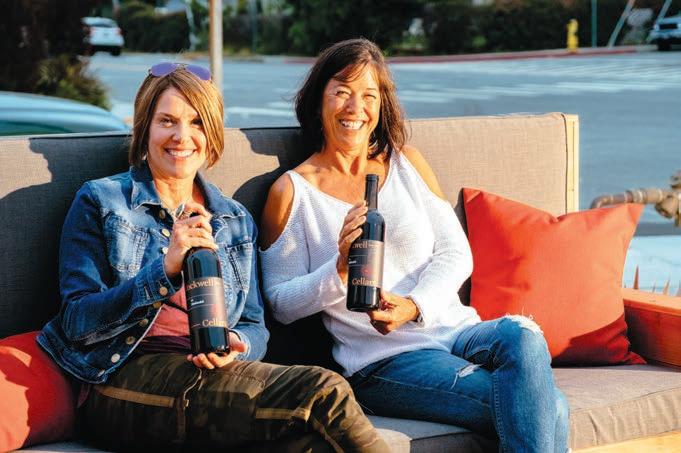


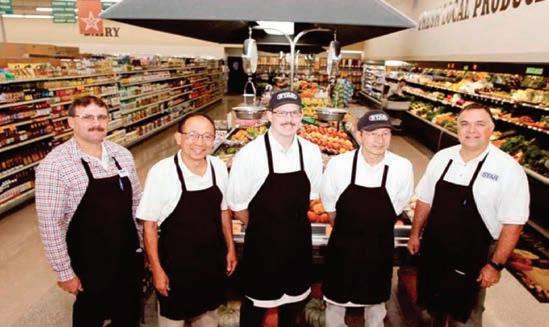





only part of the program. The seafood-centric menu ups the atmospheric effect with contemporary takes on a Monterey cioppino pot, seared sea scallops, Dungeness crab dip and Thai-style steamed mussels. Specialty cocktails, organic fresh-pressed juices and curated small batch beers and wine complete the affair. Open 7am–9pm daily.
Sea Harvest Restaurant & Fish Market
598 Foam Street
831.626.0547 • seaharvestmonterey.com
This fresh and casual seafood spot near Cannery Row is perfect after a day exploring the Monterey Bay Aquarium. There are grilled entrées and lots of fried options with chips, including calamari, clams, prawns, scallops and oysters. Try Sea Harvest’s popular clam chowder or a basket of crispy artichoke hearts. Open daily 9am–7pm.


Tidal Coffee
400 Cannery Row
831.645.4030 • tidalcoffeemonterey.com
Thoughtful coffee blends with organic beans headline here, but picnic-lunch goodies and house-made sandwiches also come recommended. Monkey bread, maple scones and almond croissants feature in early, followed by soups, salads and panini like the roast beef with horseradish aioli, grilled onion, slices tomatoes, smoked mozzarella and pickled peppers. The coffee shop aesthetic is cute, but the adjacent decks overlooking Monterey Bay present a superior spot to spoon a fig-mascarpone or vegan chocolate-hazelnut gelato with a fresh cortado. Open Tu–Th 6am–noon, F–M 6am–4pm.
The Wild Plum Café & Bakery
731 Munras Avenue
831.646.3109 • thewildplumcafe.com
Located in Old Monterey in a vibrant and diverse neighborhood, Wild Plum draws people from all walks of life with sustainable bistro fare that uses organic, locally sourced produce, hormone-free Diestel turkeys roasted on site, grass-fed beef and house-baked bread and pastries. Breakfasts include scrambles, omelets, and breakfast tacos and burritos and for lunch, soups, salads, paninis and burgers. A new grab-andgo location at Ryan Ranch is set to open in March, with breakfast, lunch, bakery items and espresso drinks. Open W–M 7:30am–3:30pm. Closed Tu.

Sea Harvest
2420 Highway 1
831.728.7081 • @seaharvestmosslanding
Outdoor tables on a wooden deck overlooking Elkhorn Slough are the perfect place to enjoy fresh seafood hauled in by a fisherman who is part of the Deyerle family that runs the restaurant. Choose from grilled catch of the day, shrimp Louie, fish and chips or some of the best Baja-style battered fish tacos around. Open daily 11am–7pm.

Woodward Marine Market
10932 Clam Way
831.632.0857 • woodwardmarinemarket.com
Moss Landing, population a few dozen, enjoys an outsized amount of beaches, marine research institutes and, thankfully, eateries. Its newest ranks among the most inviting. WMM occupies a historic location at the Moss Landing Harbor fuel dock that delivers place-appropriate fuel for the eager eater. Clam chowder, crispy artichokes and Monterey Bay calamari lead the way on the appetizer front. A pair of salads offers roughage with style. Plates and bowls round out the menu—think bouillabaisse, fish and chips, Woodward burger, artichoke-prosciutto sandwiches and seared fish tacos. Local wines and Prosecco available, as well as local craft beer, including Alvarado Street, Other Brother, Fruition and Corralitos brewing. Wood-fired pizza coming soon. F–Su. Open Tu–Sa 11:30am–6pm, Su 11:30am–4pm.

Julia’s Vegetarian
1180 Forest Avenue, Suite F
831.656.9533 • juliasveg.com
Voted the best vegetarian restaurant on the Monterey Peninsula for more than 10 years running, Julia’s is known for its wild and exotic mushrooms and house-brewed kombuchas on tap. The menu features a creative twist on vegan, vegetarian and gluten-free food. Try some of the most popular dishes like the fried “egg and bacon” sandwich, exotic mushroom sampler and buffalo cauliflower wings. Open daily for breakfast, lunch and dinner.
DUCK


Spotted Duck
542 Lighthouse Avenue
831.920.2662 • spottedduckpg.com
Spotted Duck represents a dream come true for Chef Jerry Regester, who’s been working his whole career for this moment, and a revelation for eaters. He does approachable cuisine with seasonal sourcing and comfort food instincts—think seared duck breast with green tomato and ginger jam, drunken octopus with preserved black bean honey sauce, and caramelized sea scallops with porcini mushroom blanquette. Located in the historic Holman Building in downtown Pacific Grove, Spotted Duck is an unpretentious, welcoming restaurant using quality ingredients and great technique. A new weekend brunch widens the possibilities. Open Th–M 5–8pm.
Inaka Japanese Restaurant
313 Third Street
831.593.5100 • facebook.com
Beloved by locals, Inaka has a vast menu of Japanese appetizers, soups, salads, tempura, teriyaki and noodle bowls, but most people come for the sushi. Try the San Juan roll with spicy tuna, cucumber and tempura crumbs topped with maguro, hamachi and avocado. There is also a wide selection of vegetarian rolls and a dozen different sakes, some brewed locally in San Benito County. Open W–Su 4–8pm.
Lolla
201 Third Street
831.593.5064 • lollasjb.com
Owner Sarah Griss has created a soup, salad and sandwich luncheonette in an adobe building right across the street from San Juan Bautista Historic Park. Lolla sources healthy food from local farms and food producers, giving customers a quick and convenient way to eat locally, seasonally and deliciously. Daily special soups are not to be missed. Open W–Su 11am–3pm.

Margot’s Ice Cream Parlor
211 Third Street
831.623.9262 • margotsicecreamparlor.com
Bringing smiles to the people of San Juan Bautista for 25 years, Margot’s was originally opened as a retail outlet for wonderful handmade candies, including chocolatedipped apricots, almond butter crunch, marshmallows, oreos, grahams and pretzels, as well as 10 flavors of chocolate truffles. In addition, it offers 28 flavors of Lappert’s ice cream, espresso drinks and Dole pineapple whip. Open M–Th 11am–7pm, F–Su 11am–8pm.

Vertigo Coffee Roasters
81 Fourth Street
831.623.9533 • vertigocoffee.com
Artisanal coffee roasted on site as well as fresh pastries baked in-house, brunch items, local craft beers and wines, plus wood-fired pizzas with naturally leavened, twice fermented sourdough crust have made Vertigo a locals’ favorite as well as a great find for visitors en route to the San Juan Mission, Pinnacles or other area attractions. Check website for current hours.


Housemade pasta for Seabright, Santa Cruz and the world since 2006.
538 Seabright Ave | 831-457-2782 lapostarestaurant.com
Wednesday through Sunday, we open at 5pm.

• Bio-Identical Hormones
• Thyroid Disease
• Adrenal Health
• Cardiovascular Health
• B12 Injections
•PRP
• Testosterone Replacement
• Anxiety and Depression


• Preventative Holistic Medicine
• Functional Medicine
• Nutritional IV Therapies
• Pediatrics
Call to schedule a free 15 minute intro with one of our Doctors

Windmill Market
301 The Alameda 831.623.2956
San Juan’s friendly neighborhood grocer has everything you need for a picnic or quick meal, with ample outdoor tables and booths around the windmill. A full-service deli counter and taquería offers made-to-order sandwiches and Mexican specialties like tortas, burritos, tamales and combo plates. There is also a salad bar, a hot bar and plenty of grab-and-go items. Open daily 6am–9pm.
Barceloneta
1541 Pacific Avenue, Suite B
831.900.5222 • eatbarceloneta.com
With its cheerful beach stripes, wicker light fixtures and whimsical details, dinner at Barceloneta can feel like a holiday. Owned by chef Brett Emerson and his wife Elan, who ensures service is superb, Barceloneta offers Spanish tapas made with seasonal, farmers’ market produce and several types of authentic paella, along with Spanish wines, beers and cocktails. Open Tu–Sa 5–8:30pm. Closed Su–M.
Bookie’s Pizza

736 CHESTNUT ST, SANTA CRUZ • 831.477.1377 • SCNMC.COM




1315 Water Street bookiespizza.com



Located inside the Santa Cruz outpost of Sante Adairius Rustic Ales, Bookie’s Pizza is owned by fine dining veteran chef Todd Parker and offers “inauthentic” Detroit-style square pies. Each pizza is made using the best seasonal ingredients from local farms, fishermen and foragers. Dough is made with organic flour, naturally leavened for 48 hours, and each pizza comes with its own unique sauce. Open Su–Th noon–9pm. F–Sa noon–10pm.
Charlie Hong Kong
1141 Soquel Avenue
831.426.5664 • charliehongkong.com
Charlie Hong Kong has been providing the Santa Cruz community with healthy, sustainable, affordable and high-quality food since 1998. The colorful, casual eatery’s delicious fusion of Southeast Asian influences and the Central Coast’s local organic produce have made it an inclusive, family-friendly, neighborhood favorite. Its slogan is “love your body, eat organic,” and its cuisine is proof that fast food can be good for you. All signature dishes are vegan with the option to add meat or fish. Gluten-free options are available. Dog friendly. Open daily 11am–10pm.
Crow’s Nest
2218 E. Cliff Drive
831.476.4560 • crowsnest-santacruz.com
A perfect spot to enjoy breakfast and lunch or catch a dinnertime sunset over the harbor, the nautical-themed Crow’s Nest is a Santa Cruz institution that never goes out of style. There’s always something happening, from live music to comedy nights and happy hours. Famous for its salads, house-smoked salmon and seafood entrées, the Crow’s Nest is a member of Seafood Watch and is a certified green business. Open M–F 9am–8:30pm, Sa–Su 8am–8:30pm.




Far West Fungi
224 Laurel Street, Suite A101
831.226.2626 • farwestfungi.com


The air surrounding the cozy café in downtown Santa Cruz is always infused with the delightful scents of savory mushrooms and truffles. Each visit offers a fresh experience with the seasonal menu featuring a variety of cooked and fresh mushrooms, while the extensive selection of dried mushrooms, tinctures, books and cultivation supplies ensures your pantry stays stocked with rare foraged treasures. Indulge in must-try delights like candy cap mushroom cookies, hot mushroom empanadas and truffle grilled cheese, complemented by locally brewed kombucha on tap. Open daily 11am–5pm.

Gabriella Cafe
910 Cedar Street
831.457.1677 • gabriellacafe.com
A charming dining spot inside a Spanish-style bungalow, Gabriella Cafe pioneered farm-to-table cusine in Santa Cruz. Head chef Gema Cruz serves a seasonal CaliforniaItalian menu starring organic produce from local growers and the nearby farmers market, as well as humanely raised meat and sustainable seafood. There is a candlelit patio and a cozy dining room that showcases the work of local artists. Open for lunch Tu–F 11:30am–2:30pm, dinner Tu–Sa 5–9pm, brunch Sa–Su 10am–2:30pm.
The Grille at DeLaveaga
401 Upper Park Road
831.423.1600 • delaveagagolf.com/dining
DeLaveaga earns obsessive attention for its trails, golf and disc golf, and it also enjoys a worthy epicurean program. The grill’s backdrop enhances the experience, with absorbing views, an outdoor patio and deck, welcoming fireplace and well-appointed bar. Food goes continentalCalifornian, local and organic, starring breakfast and lunch dishes like the croissant Benedict, the “Moss Landing-style” breakfast sandwich, the DeLa Black Angus burger and the “wedge shot” Louie salad with crab, bay shrimp or both. Open W–Su 8am–3pm.

Hanloh Thai Food
1011 Cedar Street
831.854.7525 • hanloh.com
This community favorite from chef-owner Lalita Kaewsawang offers standout “nostalgic cooking rooted in Thai tradition,” at a residency inside the stylish Bad Animal bookstore. Bright flavors begin with Hatsu oysters with nam jimm dipping sauce and pomelo-grilled shrimp salad tossed with chili jam dressing and Thai herbs. Entrées include lemongrass black cod, claypot pork belly confit and double fried chicken thighs with coriander. That all comes complemented by friendly hospitality and a wide selection of natural wines. Open W–Su 5–9pm.


Ivéta Downtown
545 Pacific Avenue
831.423.5149 • iveta.com
This new restaurant at the lower end of Pacific Avenue near the beach provides a casual dinner experience and weekend brunch reminiscent of European seaside cafes. Don’t miss the seasonal salads, tasty appetizers, fresh pastas and the curated selection of fine wine and craft beer. Ivéta also operates cafés on the Westside of Santa Cruz and on the UCSC campus, in addition to manufacturing and distributing award-winning scone mixes throughout the USA. Pick up a package while you’re there and be sure to try the espresso drinks and house-made desserts. Open for dinner daily from 4:30–9:30pm, and for brunch Sa-Su from 9:30am–2:30pm.

Johnny’s Harborside
493 Lake Avenue
831.479.3430 • johnnysharborside.com
With sweeping views of the Santa Cruz Yacht Harbor, Johnny’s location assures fresh off the boat seafood. Steamed Dungeness crab with drawn butter is always a good choice in season, but don’t miss the clam chowder, fish and chips or Johnny’s authentic Italian-style cioppino. Crab-encrusted salmon, shrimp scampi and California halibut entrées are customer favorites, along with fish tacos, burgers and beer-steamed clams. Open T–Su noon–8:30pm. Closed M.

Laílí
101B Cooper Street
831.423.4545 • lailirestaurant.com
Exotic flavors of The Silk Road are served in a stylish dining room decorated in eggplant and pistachio colors and on a hidden candlelit patio. Locals rave about Laílí’s homemade naan served warm from the oven with a se-




lection of Mediterranean dips. There is a wide variety of deliciously spiced vegetable dishes, and all meats are hormone free and free range. Open Tu–Sa 4–8pm.
La Posta
538 Seabright Avenue
831.457.2782 • lapostarestaurant.com
A cozy neighborhood bistro not far from the Santa Cruz yacht harbor, La Posta chef Rodrigo Serna prepares traditional rustic Italian cuisine using local ingredients. The emphasis is on simple, seasonal selections, with the balance of the menu reflecting whatever produce is freshest right now. La Posta also offers a great selection of Italian wines and a heated outdoor patio. Open W–Th 5–8:30pm, F–Sa 5–9:30pm, Su 5–8:30pm. Closed M–Tu.
New Leaf Community Markets
1134 Pacific Avenue
831.425.1793 • newleaf.com
New Leaf’s headquarters in a former bank building on Pacific Avenue is a worthwhile stop for all foodies. Crowded with gourmet natural foods, it also has a deli with sandwiches, salads and hot entrées. A dining area out front is great for people watching and listening to street musicians. Open daily 8am–9pm.
New Leaf Community Markets
1101 Fair Avenue
831.426.1306 • newleaf.com
The Westside New Leaf has a large deli counter and coffee bar, with a big selection of sandwiches, salads, bakery items, soups and other hot foods. You can eat at an in-store counter or at tables outside. Open daily 7am–9pm.



The Penny Ice Creamery
913 Cedar Street 831.204.2523 • thepennyicecreamery.com
Lines out the front door of its converted Spanish bungalow are evidence of Penny’s popularity. All ice cream, including bases, is made from scratch on the premises using local organic ingredients when possible. Dozens of exotic flavors rotate seasonally, but two favorites are chocolate caramel sea salt and strawberry pink peppercorn. Open daily noon–11pm.
The Picnic Basket
125 Beach Street 831.427.9946 • thepicnicbasketsc.com
Across the street from the main beach, owners of The Penny Ice Creamery offer an alternative to boardwalk fast food. Sandwiches, organic salads, coffee and beer, all from local food artisans, and of course Penny’s popular ice cream, are all on offer to eat in or outside with your feet in the sand. A small selection of grab-and-go foods will be added when The Picnic Basket reopens this spring. Open daily 7am–4pm.
Pretty Good Advice
1319 Pacific Avenue prettygoodadvicesoquel.com
Founder Matt McNamara, fleeing the world of fine dining, changed the vegetarian game in Soquel back when he opened PGA in 2019, with savory soups, chopped salads and indulgent all-day ciabatta breakfast sandwiches like the pesto fresco. Now its new downtown location extends all the earthy goodies of thoughtful meat-free fare to that many more healthy eaters. Open daily 9am–3pm.
Staff of Life
1266 Soquel Avenue 831.423.8632 • staffoflifemarket.com
A Santa Cruz landmark, Staff of Life started in 1969 as a small natural foods bakery and has grown over the years into a full service natural foods supermarket known for

its local organic produce, seafood and natural meats as well as an extensive bulk department. Deli items and foods from the hot bar can be enjoyed at the Café del Sol. Open daily 8am–9pm.
The Pizza Series
226E Mt. Hermon Road
831.600.8318 • thepizzaseries.com
Chef and world champion pizza thrower Matt Driscoll plans to open his own long-dreamed-about pizzeria in early summer in the spot formerly occupied by Tony & Alba’s, next door to CineLux Scotts Valley. Meanwhile a wide variety of Detroit-style square pies and New York-style round pizzas are available to go Wednesday to Sunday, including cup-n-char pepperoni, sweet heat and BBQ Kauaiian. Open W–Sa noon–8pm, Su noon–7pm
Other Brother Beer Co.
877 Broadway Avenue
831.474.1106 • otherbrotherbeer.com
The main attraction here is fresh, delicious beer. However, the brewery’s brand new kitchen inspires a visit on its own. Not coincidentally, dishes are designed to pair poetically with Other Brother’s house beers. The menu features goodies like: Our signature smashburger, fried chicken sandwich, wings, fries, a hearty smoked BLT, a lovingly-crafted spicy capicola sandwich, creative and refreshing salads and a stunning beet-and-whipped-goat-cheese toast topped with watermelon radish, edible flowers, sea salt and Like Family extra virgin olive oil. Taproom open M–Th 11:30am–9pm, F–Sa 11:30am–10pm, Su 11:30am–8pm.

HOME
3101 N. Main Street
831.431.6131 • homesoquel.com
Plenty of restaurants aspire to extend the type of hospitality you get at a best pal’s place. Here that happens in ways that honor the name. Dishes like abalone cassoulet, wild mushroom ricotta gnocchi and panzanella salads, curated local wines and, yes, a homespun setting—starring a huge vegetable garden in back— help chef Brad Briske and his snout-to-tail program shine. Speaking of meat, the beef tongue, steak tartare and bone marrow rank among the reasons to head HOME. Open W–Mon 5–9pm.

Pretty Good Advice
3070 Porter Street
831.226.2805 • prettygoodadvicesoquel.com
Open daily 8am–5pm. See PGA description under Santa Cruz for more.
Staff of Life
906 E. Lake Avenue
831.726.0240 • staffoflifemarket.com
Opened in 2021, Staff of Life’s second store in Watsonville is its first and only branch. The store is sustainable down to its bones and includes all the natural groceries, organic produce and includes all the natural groceries, organic produce and baked goods you would find at the Santa Cruz store, along with a juice and smoothie bar, freshly made sushi, a gelato bar, a full deli and a hot bar. Open daily 8am–8pm.

It proves difficult to quantify Alex Mouzouris’ depth of cocktail wisdom.
After nearly 20 years in the industry, countless cocktail conferences, myriad product launches and dozens of drink program debuts from Paris to Seaside, the London native’s understanding approaches encyclopedic.
Also hard to gauge: his passion for rum, which he studied for years as brand ambassador for 150-year-old liquor legend and sixth-generation Puerto Rican spirits house Destilería Serrallés.
“The most versatile spirit in existence,” says Mouzouris, currently beverage director at Heirloom Pizza Co. in Salinas. “And there’s rum made in more places than wine. Every island, every place that makes rum, is different.”
His appreciation for drink-making in his native London—versus, say, New York or Barcelona—is not as tricky to sum up. “No place is better,” he says.
Same for his thirst to stir up Monterey Bay Area’s cocktail game. “A good drink program takes as much effort as fine dining,” he says. “People don’t get it. It’s a whole unexplored world around here.”
But if and when you do measure any of those elements, make sure to do it metrically.
“I work in milliliters, not in ounces,” he says. “I am aware that I live in America and how things work here, and I’m delighted to be a citizen. But ounces are stupid and they make unbalanced drinks.”
For him, the magic of millimeters goes beyond familiarity and smooth conversions: It allows for the precision that helps define his approach to the craft—which also involves the use of tools like sous vide machines and food-grade acids.
Heirloom co-owner/operator Mike Foley enjoys observing how customers respond to Mouzouris creations like the Chamomile Collins with wildflower honey, the Jungle Stirred with baked pineapple rum and his whiskey sour, the pedigree and tartness of which Mouzouris takes personally.
“He’s elevating our drink program, and in general he’s elevating our vibe,” Foley says. “The food sells itself, and the bar is another piece of that puzzle, bringing out our name and product to Salinas to people who can appreciate it. People aren’t necessarily expecting that.”
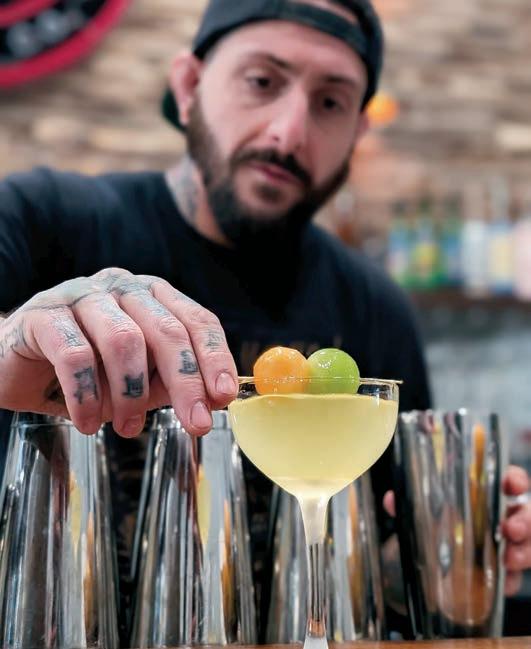
Gabe Georis, owner of Barmel, has worked in hospitality for decades, and sees something uncommon in Mouzouris, who briefly helmed the drinks program there. “Alex has a gift for creating balance in his drinks,” Georis says. “Subtlety and finesse, it’s all there."
Mouzouris’ rum allegiance bodes well for Heirloom’s forthcoming Mainlanders Tropical Bar upstairs (slated for late summer opening), which layers on promise for Oldtown’s ongoing rise, and rum’s historic resurgence overall.
“Rum built the New World, all of this, in some fashion or another,” Mouzouris says. “At one time, it was worth the same as its weight in gold.”
To be clear, he 1) genuinely finds that equivalency fair, and 2) is measuring that weight in kilograms.
Alex Mouzouris can get intense about things he cares about. That includes intellectual property like the cocktail tricks he’s developed—and isn’t about to hand over—no matter how nicely one might ask. So this recipe involves some mystery, and thereby inspires some home experimentation. It also illuminates by way of its nerdiness, seasonal savvy and metric exactitude.
22.5 ml Melon Man cordial (recipe follows)
60 ml Roku Japanese yuzu gin 1 ball cantaloupe, for garnish 1 ball honeydew, for garnish
Stir first two ingredients in ice. Strain into frozen cocktail glass. Garnish with 1 ball of each melon. Makes 1 drink.
For the Melon Man cordial
Peel and chop ½ cantaloupe melon and ½ honeydew melon, cook sous vide then combine with 3 peeled mandarins and add to 1 liter of simple syrup that’s been acid adjusted (try punchdrink. com for tips). Blend thoroughly. Bottle and keep chilled for at least 2 hours before using.


Certified Organic Cafe & Bakery
Our Farm Stand proudly serves breakfast and lunch, Sightglass specialty coffee, Rishi loose leaf tea, signature smoothies, Straus Family Creamery soft serve, natural & local beer + wine, curated gifts + housewares, grown here produce + flowers, market provisions and pantry staples.
7250 Carmel Valley Road, Carmel, California 93923
(831)625-6219 Earthboundfarm.com
